QUANTUM LEAP

– SOCRATES




“IT IS A SHAME FOR A MAN TO GROW OLD WITHOUT SEEING THE BEAUTY AND STRENGTH OF WHICH HIS BODY IS CAPABLE”














– SOCRATES




“IT IS A SHAME FOR A MAN TO GROW OLD WITHOUT SEEING THE BEAUTY AND STRENGTH OF WHICH HIS BODY IS CAPABLE”













The Spanish photographer lives in Austria, documenting his passion for snowboarding – and anything else that piques his curiosity. He visited the Nürburgring to shoot the World Rallycross series for this issue. “I was impressed by the acceleration of the cars, and the precision needed to control them,” he says. “The teams are pushing into the unknown with the move to electric.” Page 5 0
Progress relies on people daring to do things differently, and in this issue we feature athletes willing to leap into the unknown – literally, in the case of our cover star, cliff diver Aidan Heslop (page 32). The 20-year-old from Plymouth – who is pictured on our cover performing the world’s hardest dive in Polignano a Mare, Italy, in 2022 – is pushing his sport into a new era with dives so complex they’ve never been attempted before. His latest creation is about to push the bar higher than ever, and could see him become a world champion this year.

Then we meet the warring dynasties of the World Rallycross Championship (page 50), a series which last year entered a brave new world that’s fully electric and faster than F1, presenting spectators with a multisensory experience thanks to engines that purr rather than roar.
The award-winning writer and editor, based in Ontario, Canada, has written for The Atlantic and The New Yorker. Interviewing Aidan Heslop in Montréal gave him a fresh perspective on cliff diving. “Aidan’s dives appear effortless,” he says. “He’s just as comfortable in the air as he is on solid ground. It’s clear his willingness to test his physical limits is changing the sport.” Page 32

And we conquer new heights with Lebanese climber and professional ‘mover’ Nelly Attar (page 42). Before she scaled summits, Attar went underground, using her dance skills to bring movement to women in her adopted home of Saudi Arabia, where physical activity has historically been severely restricted.
Enjoy the issue.







8 Gallery: highlights from global photography contest Red Bull Illume, including a legend of the falls in Iceland; ‘hoverboard’ trickery in Salt Lake City, USA, and tilting at (broken) windmills in northern Spain. Plus, some F1 time travel in the Czech Republic
15 Halcyon tracks: award-winning singer-songwriter Ellie Goulding revisits four cherished songs
16 Free ride: how the trans bikers of Original Gents MC are changing the stereotype of the motorcycle club
19 To dye for: meet the biologist extracting pigments from fungi
20 Not-so-minibeasts: going large on the plight of the insect world
22 Grand designs: turning unwanted pianos into concert venues
24
The ultrarunner on injury, mental strength, and how you can join his team in the Wings for Life World Run
26 Luke Shepardson
It’s lunchtime. Grab a sandwich? Not if you’re this lifeguard turned unlikely big-wave surf champion
28 Jodie Harsh
Home is where the beats are, says the DJ, party girl and music-maker
32 Aidan Heslop
We talk to the young British cliff diver who’s transforming the sport with his audacious, next-level leaps
42 Nelly Attar
This inspirational Lebanese mountaineer is a mover and shaker – in more ways than one
50
Inside the fully charged, all-electric, mixed-terrain rally series where family pride is at stake
64 America’s Cup
A state-of-the-art racing yacht is only as good as the crew of humans who sail it. Here’s why…
73 Total ledge: the highs and lows (but mostly highs) of big-wall climbing in Chamonix
79 You snooze, you win: how to get the sleep of your, erm, dreams
80 Block head: why an addiction to Tetris might not be a bad thing
82 Fit for purpose? The phenomenon of FitTok, and how to spot the cons
84 Power trip: everything you need for your next electric mountainbiking adventure
94 Essential dates for your calendar
98 Outdoors wisdom from Semi-Rad
50
Scraping victory: World RX races may be short and fast, but they’re no less punishing


Prior to this project, David Nogales Tarragó was a novice at photographing river sports. But when you’re invited to Iceland to shoot a giant of kayaking – Aniol Serrasolses (pictured) –anticipation beats trepidation. This image, shot at the 20m-high Aldeyjarfoss waterfall – “one of the most beautiful I’ve ever seen, because of the energy of the water and the strange basaltic stone formations” – won the Spaniard a semifinal place in global photography contest Red Bull Illume. dnogales.com; redbullillume.com

They may resemble Hot Wheels from this distance, but you’re looking at two eras of excellence in motor-racing engineering. Formula 1 legend Sebastian Vettel’s 2011 Drivers’ Championship-winning RB7 (top) and the Tatra T607 – the 1951 Czech F1 car that never was – were brought together by lensman Jirí Šimecek. For his Time Lap project, he shot them racing side by side, using an era-specific camera for each, to highlight advances in photography and motorsports. Sadly, this is the closest the T607 ever got to elite competition – the Cold War scuppered its plans. jirisimecek.com

You don’t see a “Jesus-like kick-flip out of the Great Salt Lake” – as photographer Dan Krauss calls it – every day. In fact, you almost didn’t see this one. The Salt Lake City native was prepping submissions for Red Bull Illume when, he says, “I realised I’d shelved an idea I had tech-scouted the previous year: a unique look at forced perspective to create a surrealist dystopian environment.” With snowboarder and skater Jack Hessler on board (where else?), Krauss rebooted the project, bagging himself a semi-final spot as a result. dankraussphoto.com; redbullillume.com

“I’d long heard about a certain location [where] some pieces of torn-apart windmills had been left to rot,” says Spanish photographer Ismael Ibañez Ruiz, “so my [BMX rider] friend Sergio Layos and I decided to take a look. It was love at first sight… Curves, lines, hips and transfers galore.” Ruiz’s image won him a semi-final place in the ‘Masterpiece by SanDisk Professional’ category of Red Bull Illume, but sadly this BMX wonderland has since been destroyed. At least we have the photo. Not as much fun to ride, mind. ismaelibanezphoto.com; redbullillume.com
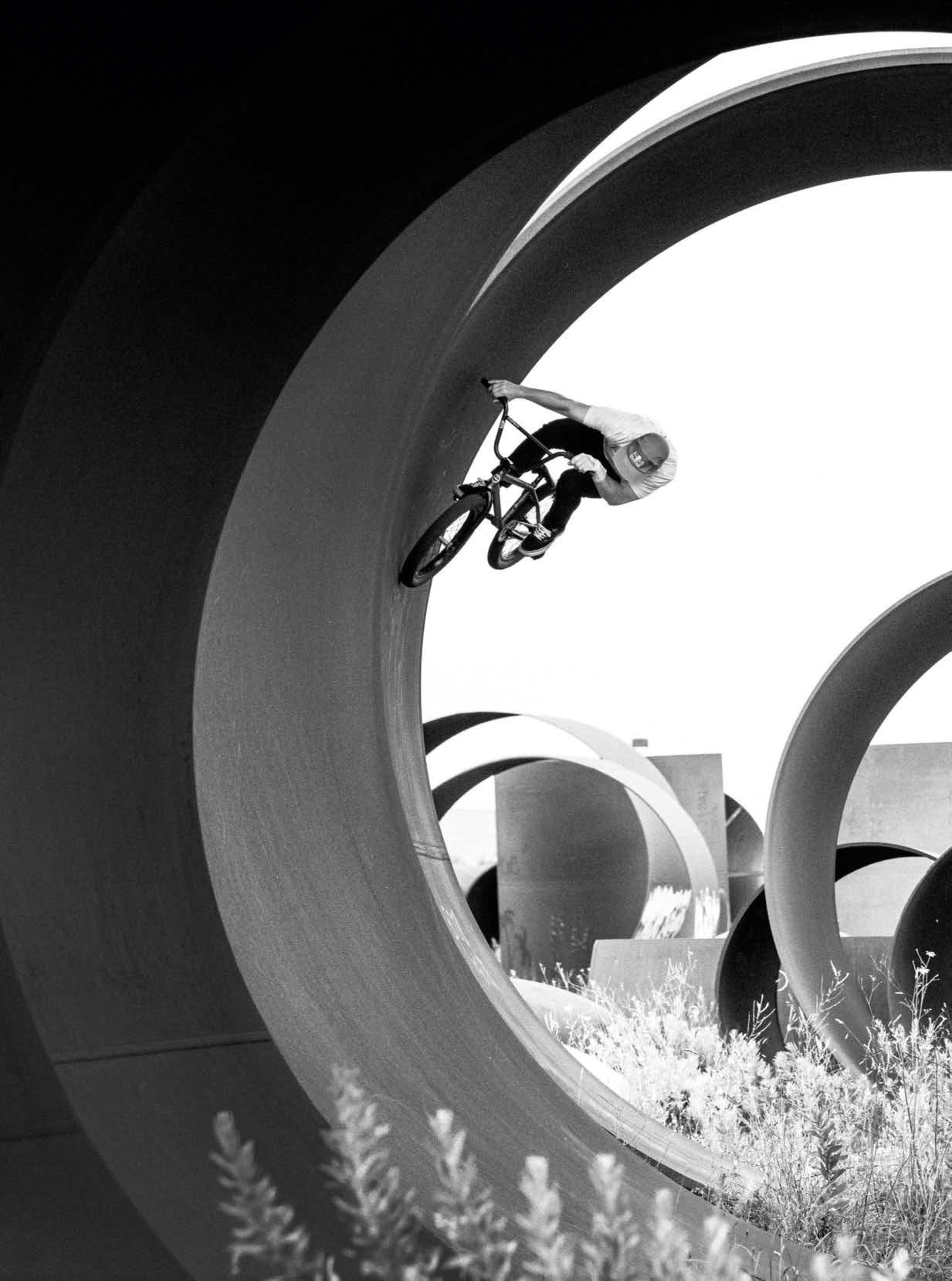

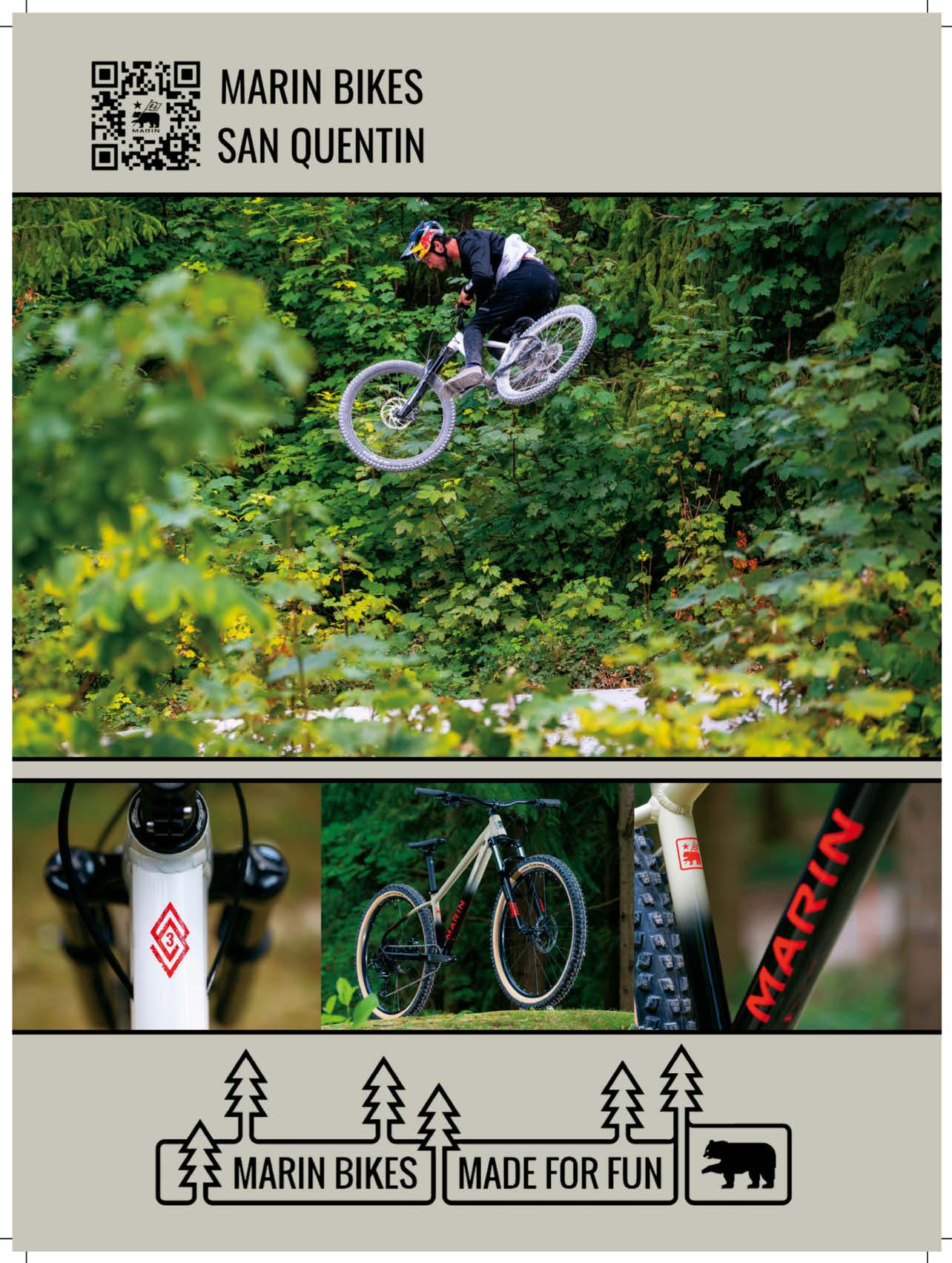 ELLIE GOULDING
ELLIE GOULDING

The award-winning British singer-songwriter revisits four songs that have played a crucial role in her musical education
A pop career wasn’t always assured for Ellie Goulding. Raised by her mum in a council house in Herefordshire, with three siblings – her funeraldirector dad left when she was five – Goulding went on to fail music at A level. But she’d been writing songs since the age of 15 and possessed ambition to match her talents. Now 36, she has three platinum albums to her name, along with two BRIT Awards, and a Grammy nomination for her 2015 hit Love Me Like You Do. To mark the release of her fifth studio album, Higher Than Heaven, the mother of one waxes lyrical on four songs that have inspired her. elliegoulding.com
Blur Parklife (1994)

“This track shaped me as a lover of music, because it was the first song I ever bought and it kickstarted my love of indie and rock. It was just the most visceral kind of reaction to music back then, and I think we need that right now. It’s harder and harder to just sit there and listen to ballads about how depressing everything is.”
The Miseducation of Lauryn Hill (1998)

“This opened up a whole other world. It changed things, because it made me want to sing. I loved how personal it was, I loved the tone of her voice, I loved the inflections in her voice, I loved how powerful and direct it was, I loved the energy. It was really groundbreaking.”
Fleetwood Mac Dreams (1977)

“Dreams is a classic. I just didn’t know that something could sound so good! [Laughs.] I’m jealous of anyone listening to this song for the first time, and, of course, people are hearing it on TikTok now. I first discovered it while listening to a friend’s radio. I was just like, ‘Wow, this is such a beautiful song.’ It was like a revelation for me.”

Hanging On (2011)
“This song is a bit more modern – I actually did a cover of it. It’s a combination of this choral voice, very high, and music that’s hip-hop influenced but like a choir, ethereal. It’s impossible not to love, it’s so beautiful. And it’s like nothing I’ve ever heard before. It’s just amazing. Check it out!”
As a trans man, Dakota Cole didn’t feel accepted by other bikers. His solution? To start a new kind of motorcycle club

When Dakota Cole is out with his motorcycle club, he likes to ride his Honda Shadow 750 at the back of the group, where he can see his brothers making the most of the open road.

“I love seeing massive groups of motorcyclists,” the 31-year-old says. “Before we got a road captain, I used to lead, but I didn’t like that too much. As soon as we got a captain, I moved to the back… For me, being on a motorcycle is the ultimate feeling of freedom. You’re not encased in a car; you’re just going down the road feeling everything.”
Cole is co-founder of the Original Gents MC in Kansas
City, the world’s only motorbike club for transgender men. But until Cole helped establish the club, the freedom he felt on a motorcycle was at odds with his experience of traditional biker settings, which he found “very judgemental”, he says. “It’s not trans-friendly. I hate to say this, but cis white men on motorcycles are misogynistic and prejudiced. I knew that if I ever joined a club, I’d have to be stealth [to pass as cisgender] from beginning to end.”
And so, in 2020, Cole co-founded the Original Gents MC, which – contradictory to the reputation of motorbike club culture for illegal activity and aggression – is based on moral values: “Our number one rule is to always treat people with respect.” Choosing a name was the next crucial step and it required careful consideration. “We wanted a name that conveyed we were trans men, but without outing ourselves,” he says. “That can be dangerous – sometimes you see the Pride flag and it makes you a target, especially if you’re in the middle of the US.”
Ultimately, Original Gents MC fitted because “it plays on the fact that even though we were assigned female at birth, we were men from the beginning”.
The number of members has now doubled from the original four to eight, who, aside from being trans men and bikers, are from all walks of life; Cole is a computer technician for federal government, while others work in insurance, hospitals and car dealerships. But every month they proudly ride together.
Out on the road, the Original Gents MC might look like any other motorcycle club, but its very existence is activism in action. It provides safe, inclusive, non-judgemental spaces such as open rides for non-members, monthly bike nights at an LGBT brewery in Kansas City, and a memorial ride on November 20 every year for the Transgender Day of Remembrance.
“A motorcycle club badge has your name, logo and usually your territory,” says Cole. “But we don’t claim territory; we’re not that kind of club. Ours says ‘Brotherhood’ instead.” originalgentsmc.org


This molecular biologist is bringing sustainable colour to the fashion industry, courtesy of the wild world of fungi
It was in 2020 that fungi began to take over Jesse Adler’s life. The biomolecular scientist was working for Pangaia, a materials science fashion brand, during a year’s break from her MA in Material Futures at London’s Central Saint Martins (CSM) and looking for a topic for her final thesis. Then inspiration struck.
“I noticed that there was a need for more colours, more variations, higher performance; things that looked synthetic but were natural,” says the Detroitborn 26-year-old. “Then I saw Fantastic Fungi [a 2019 film by US director Louie Schwartzberg] and I was in awe of all the colourful fungi out there! So began the rabbit hole…”
Adler saw the potential in the world of fungi – organisms that include yeast, mould, lichen and mushrooms – for creating vibrant, environmentally friendly pigments. Until the mid-1800s, dyes were created by “mining, hunting and harvesting”, she says. Extracted from plants, minerals and animals, they were natural but not necessarily sustainable. Then, in 1856, British chemist William Henry Perkin – only 18 at the time –accidentally created the first synthetic dye, a purple he named mauveine, while searching for a treatment for malaria.
Today, most dyes are made from fossil-fuel derivatives and, as such, aren’t renewable. They have also become a source of pollution in our waterways, and, Adler says, “some of these colourants are more toxic than we ever realised”. She believes
mycology (the study of fungi) might have the solution. “The reason there are pigments in these organisms is because nature doesn’t see beauty, only function. For example, a wood decay fungus deposits its striking turquoise pigment as it grows and digests a log to act as antifungal protection, as if to say, ‘This is my territory –nothing else can grow here.’”
Working with a cosmetic formulation chemist, Adler created a make-up collection, Alchemical Mycology, to show potential commercial uses for fungi-derived dyes. Prototype eyeshadows, eyeliners, tinted serums and lipsticks were made in shades of red, yellow, brown, purple, green and blue – all extracted from lab-grown or ethically foraged fungi.

“Make-up was a provocative way to tell this story,” Adler
says, “but now I’m researching how to extract these pigments more sustainably and create different outcomes. The dream is for this to become as scalable as brewing beer.”
Now a self-described “mycological alchemist”, Adler is continuing her work in a research fellowship with CSM and the Jan van Eyck Academie in the Netherlands, exploring the many possible real-world applications of fungi-based pigments, from cosmetics and food to textiles and art supplies.
After a year spent delving into this field, fungi continue to surprise Adler every day. “I got an amazing acid green from some ethically foraged lichen the other day,” she says. “But I was supposed to get orange. That’s the beauty of nature!” jadlerdesign.com

Photographer Levon Biss is turning minibeasts into giants to show the true scale of their plight
When London photographer Levon Biss (pictured with his camera rig, above) came to shoot the giant Patagonian bumblebee for his 2022 project Extinct & Endangered, a collaboration with the American Museum of Natural History (AMNH) in New York, he tried an unconventional approach: he shot the insect from underneath. “It looks like it’s got a big mane on its back,” Biss says. “It’s an arresting image – you don’t normally see bees photographed that way.”
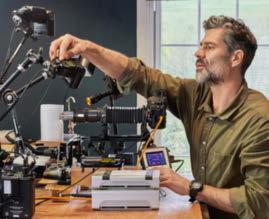
Upending our perspective on insects is at the heart of the project, currently on display at the AMNH, and online at extinctandendangered.com.


Extinct & Endangered features 40 extraordinary photos of creatures that are lost – or close to being so – for ever, from the Rocky Mountain locust (last seen in 1902) to Australia’s rarely spotted Christmas beetle. Biss photographed specimens from the AMNH’s 20-million-strong collection and enlarged the images – some to as big as 1.4m by 2.4m –for maximum impact.
A 2020 study in the journal Biological Conservation reported
All in the detail: (clockwise from top left) the ninespotted lady beetle, Luzon peacock swallowtail butterfly, giant Patagonian bumblebee, and lesser wasp moth
that our planet has lost five to 10 per cent of its insect species over the past 150 years. “It’s hard to quantify the rate of loss, because of the difficulty of monitoring them,” says Biss. “Insects are the building blocks of virtually all ecosystems. And if you don’t share an ecosystem in the right way, it gets out of balance. We need education on insects – they’re not horrible creepy-crawly things.”
Indeed, his images highlight the insects’ intricate beauty. But creating such exquisitely detailed photographs isn’t straightforward; Biss uses a homemade photography rig with microscopic lenses that can be moved in minuscule increments. “Generally, the camera will move forward around seven microns –that’s about one tenth of the width of a human hair,” he says. “When shooting at high magnification, you end up with a shallow depth of field. To get around that, you take lots of slithers of focus, creating a stack of images – maybe 500 – and then you use software to squash those together, giving you an image that’s fully focused from front to back.”

Biss splits each insect into around 25 sections, each photographed separately and with custom lighting – for example, backlighting a wing to highlight its structure. The final image is pieced together from more than 10,000 separate shots, which takes around three weeks. In total, Biss’s project took two years. But, he says, it’s worth all the meticulous work.
“When you view something at high magnification, you’re seeing things in a completely different way. With insects, I love looking at the engineering; they’ve adapted to their environment in such an impressive way. But then, when you’re working with an extinct insect, it’s humbling to know this thing will never fly again. Nature has evolved over thousands of years to create this creature, but now it’s not there. It’s a fragile thing.” Extinct & Endangered is at the AMNH, and the book Extinct & Endangered: Insects in Peril is out now; amnh.org

PIANODROME
These Edinburgh musicians have found the key to keeping old pianos out of landfill



A hundred years ago, the piano was a focal point in many a living room; a status symbol and source of entertainment at the heart of the family home. But thanks to changing lifestyles, technological advances, and living space being at a premium, subsequent years have seen it replaced by the TV, the computer and mobile devices. As a result, hundreds of pianos – neglected and out of tune – have become destined for landfill.
This is what Edinburgh musicians Matthew Wright and Tim Vincent-Smith discovered seven years ago when the latter got talking to a piano mover he had hired, named Jerry. VincentSmith, who’s also a woodworker and a designer, asked if Jerry had any pianos going spare; within a few weeks, five had appeared on his doorstep. “They just kept coming,” says
Wright, who plays alongside Vincent-Smith (pictured below, left, with Wright) in musical trio S!nk. “Tim started dreaming about what could happen with these pianos, and he came up with the idea of making an amphitheatre. Over a couple of years, we began taking apart pianos and building prototypes.”
In 2018, they opened their first official Pianodrome at the
Royal Botanic Garden Edinburgh – a month-long residency as part of the Festival Fringe. The unique, 100-seat, in-the-round arts venue was constructed using more than 40 unwanted and repurposed instruments. “These pianos are so beautifully put together,” says Wright. “It’s partly out of respect that we’re doing this. We’re looking after them on their way to the dump. We’re intercepting them and giving them new life.”
The pianos are graded using a four-tier system, with some kept whole – each venue includes instruments that are playable – and others deconstructed to varying degrees to create ballast, accessible seating and gangways. “It’s a nose-to-tail construction philosophy,” says Wright. “We’re working with materials solely from pianos, right down to the screws, planks and structural components.”
Key to Pianodrome, though, is that “no working instruments are harmed in the making”. Its Adopt-A-Piano scheme brings restorable instruments back to life, giving them a retune and a new home. Wright and VincentSmith estimate that, to date, they have rescued around 300 pianos, with projects including a sculpture trail for the 2021 Leeds International Piano Competition, the building of a second venue for a 2022 Fringe run at Edinburgh’s Old Royal High School, and the creation of America’s first Pianodrome for the Charlotte SHOUT! arts festival in North Carolina this April. The two existing UK Pianodromes are in storage, ready for their next installation.
“We want people to appreciate the heritage and the stories bound to these pianos,” says Wright. “There are decades of family experience and love and music-making in them. This is a way of allowing these pianos, which have imbued all this stuff throughout their lives, to breathe and communicate with humans once again.” pianodrome.org
 Tom Evans
Tom Evans
Driving a pick-up truck through his temporary hometown – Sedona, Arizona – British ultrarunner Tom Evans is beginning to look like one of the locals. A cowboy hat, he jokes, is next on his list. Evans is on the first of three planned stints of altitude training Stateside, and while the 31-year-old misses his home in Loughborough, his wife Sophie, their two dogs Rocco and Poppy, and their brood of rescued batteryfarm chickens, he’s laser-focused on his upcoming American challenge.
The 100-mile (161km) Western States Endurance Run in California this June is a race Evans calls “the Super Bowl of trail running”. He’s also preparing for the Wings for Life World Run on May 7, a unique annual event that raises money for spinal-cord injury research and sees thousands of runners across the world race against a moving finishing line while being chased by a virtual Catcher Car.
Evans is putting together his own team to take on the challenge, and is more than qualified to be captain: since his statement-making thirdplace finish in the 251km Marathon des Sables in 2017, the former British Army officer, originally from Sussex, has established himself as one of the world’s top ultrarunners. But it’s another podium placing –in the Ultra-Trail du Mont-Blanc last August – that he’s most proud of, coming as it did just a year after major knee surgery.
Here, Evans talks to The Red Bulletin about the emotional investment of ultrarunning, and that big injury comeback…
the red bulletin: What do you love most about ultrarunning? tom evans: It’s not just a physical challenge but arguably a bigger one mentally. Your mind is the thing that unlocks it. I want to see how far I can push myself, and I’m constantly searching for that limit. Western States is described as ‘a life in a day’ – you go through the highest of highs and the lowest of lows, and it’s how you deal with them. You learn so much about yourself. In this sport, there are more uncontrollable factors than controllable ones, so you have to solve problems and make tactical decisions quickly. I didn’t get the same buzz from road or track running.
What has been the biggest highlight of your career?
I had major knee surgery in August 2021 and, a year after that, I raced in the Ultra-Trail du Mont-Blanc. It’s 170km with 10,000m of climbing, going through three countries. My goal for that race was to be on the starting line; I ended up finishing third. [It helped me] put all my rehab demons to bed and say, “I do belong here.” I was so emotional, because I’d worked so hard. I did believe I could do it, but deep down there was a huge question mark.
How does it feel at the finishing line after putting yourself through such a gruelling experience? Racing is relatively easy – I race four or five times a year, but I train 350 days and there’s no one watching and cheering for you [then]. So if a race goes well, it’s almost a relief that everything I did worked. It’s really emotional, both the victories
and the losses. I heard a phrase on a podcast last year: “Don’t let the highs go to your head or the lows go to your heart.” I think that’s so important. I want to be stood on the starting line knowing I’ve left no stone unturned.
Why should people join your team for the Wings for Life World Run on May 7?
Running is such an individual way to express yourself, but a team is only as strong as its parts. I want to create this team to hold me accountable to then hold all the others accountable. It’s that tribe mentality – a collective of individuals coming together to achieve something we couldn’t do on our own. I might have people in the UK, the US, Australia, Argentina, Brazil, wherever. We’re all doing it together. And Wings for Life is a charity I’ve seen do incredible work. I want to raise as much money as I can.
How far are you hoping to run?
I ran 63km last year in Vienna. So… 64?
Are your tactics different in a race like this where you’re trying to avoid the Catcher Car rather than reach a set finishing line?
It’s really important to trust yourself, go out at a pace and hold that pace. Whether I have to run, walk or crawl, I’m just going to keep going and try to get as much distance as I can between myself and the Catcher Car. It’s the same mindset that everyone should go into the race with: as long as you keep moving in the right direction, you’re doing an incredible thing. You’ve just got to put one foot in front of the other. Running is such a basic sport; in racing, all you’re trying to do is get from A to B as quickly as possible. Whether it’s Usain Bolt in the 100m or Eliud Kipchoge running the marathon, we’re all trying to do that same thing. The Wings for Life World Run starts at 12 midday on May 7; wingsforlifeworldrun.com
Scan the QR code to join Tom Evans’s team in the Wings for Life World Run
RACHAEL SIGEE
He may have plans to conquer the US, but first the British ultrarunner has his sights set on a challenge that’s closer to home – and he wants you to join him

“Wings for Life is a charity I’ve seen do incredible work”
1978] was the first lifeguard on the North Shore with a perfect record of rescues. It’s a testament to how good of a waterman and lifeguard he was. He performed so many selfless acts, ultimately sacrificing his own life to get help when the canoe he was in capsized at sea. It’s just about honouring his legacy.
Did that help you overcome the pressure of competing?
Words RACHAEL SIGEE Photography PHILIPP CARL RIEDLIt had been seven years since conditions were right for the Eddie Aikau Big Wave Invitational to take place, but on January 22, 2023, word came through: the waves were good. The Eddie was a go.
The Eddie – a surfing event held only when waves exceed 30ft [9m] in height – brought thousands of people to Waimea Bay on the North Shore of Hawaiian island O’ahu, where Luke Shepardson works as a lifeguard. The 27-year-old North Shore native had long dreamt of competing in the Eddie, and had been invited to sign up after organisers saw him surf the break back in 2016. So, this year, despite being on duty that day, Shepardson had permission from his boss to take part during his lunch break.
When the time came, the Eddie novice donned his competition jersey, ran into the waves he first rode at the age of 13 – and won. Shepardson scored an incredible 89.1 out of 90, beating some of the world’s best surfers and winning the $10,000 prize – and the respect of the surfing community.
the red bulletin: When did you start surfing?
luke shepardson: I grew up surfing with friends and family. I’ve always done it. It’s what I love to do. It keeps me in the present moment and is always there for me. It helps me get away from stuff if I’m having a hard day. Every time you get out of the water, you go back to whatever you were doing feeling better.
Did you have dreams of making it as a pro when you were younger? I did, but it wasn’t for me. I was sponsored by a local surf shop, North Shore, but they didn’t have a ton of money. I’d feel so anxious whenever I paddled out in a competition jersey. Total butterflies. I’d make mistakes that I otherwise wouldn’t have. I [won a few competitions], but generally I was putting too much pressure on myself. It took the fun out of surfing.
Why did you become a lifeguard?
It had always been a dream of mine. I tried out at 18 and then again at 20, but they wouldn’t let me in, because I was taking all this time off for surf competitions. I had my son when I was 23, and I decided I needed something solid, so I quit competing and got accepted as a lifeguard. That last competition, I made it to the semifinals. Because I knew it was my last, I didn’t put any pressure on myself.
What has been your gnarliest moment as a lifeguard?
Two of my friends got injured a couple of years apart, both at [local break] Pipeline. I saw my friend nosedive from the top of a wave and go down pretty hard. He didn’t come up, and a few surfers brought him to shore. He was non-responsive. I performed first aid and eventually he responded. But it was a long road until he was back to full health. The same kind of thing happened with another friend a few months ago.
Given the danger of big waves, what’s the appeal of the Eddie? It had always been a dream to compete. Eddie [Aikau, a local legend, who died in a canoeing accident in
Yeah, it had been a lifelong ambition because of him. And it was right there on the beach where I worked. I was overwhelmed when I took part – I cried when I put the jersey on. It’s a huge deal to everyone in the sport.
What was it like to take part?
I was preoccupied with work during the day, but when I grabbed my jersey for my heat I started tearing up. I was so stoked to achieve this lifelong goal – I was blown away that it was coming true. To be surfing among legends I’ve looked up to my whole life, and to be part of that energy, was unbelievable. I surfed as best I could, then went back to work.
Did you ever think you had a chance of winning?
The competition is in two rounds. Right before my second round, I was told the scores and what I needed to win. I knew I had a couple of good waves in my second heat, so I did have a thought I could win, but of course you never know. When they announced it, it was… I don’t even know how to explain it. The emotion that filled my body was just… I was in shock. It was one of the best moments of my life.
Has winning changed things?
I’m only really starting to process it, because on the day itself there were thousands of people I had to keep an eye on. But it’s all pretty surreal. I don’t want to give up being a lifeguard, but I would like some sponsors to help me go surf dream breaks in Tahiti and Africa – although the cold water there kind of scares me. I’m done with competitions, but I’ll never stop surfing. Ever.
Instagram: @casualluke
How the 27-year-old unsponsored lifeguard claimed victory in surfing’s biggest event – on his lunch break

“I surfed as best I could, then went back to work”
DJ, producer and songwriter Jodie Harsh found a home and happiness on the club scene as a teenager. Now she hopes her music can help others find the same thing, too
Words LOU BOYD Photography THOMAS KNIGHTSJodie Harsh is up for a party. The London-based DJ, music producer, songwriter and self-proclaimed “reigning Queen supreme over international nightlife” has been at the forefront of the UK’s club scene for the past two decades. A fixture at iconic noughties club Circus, and a gifted club DJ, over those 20 years Harsh has been pictured out on the town with everyone from Kate Moss and Paris Hilton to Lady Gaga and Amy Winehouse, and has gained a reputation as one of London’s happiest and most hedonistic party girls.
When clubs suddenly closed in 2020 at the start of the pandemic, however, Harsh’s day job and exhilarating lifestyle evaporated overnight. With a year of festival bookings, DJ gigs and public events cancelled, she made the choice to stay positive and focus on creating a party from home instead, making and releasing her own music for the first time. Her debut original single, My House, which dropped in November 2020, revealed that not only did Harsh have a musical talent away from the DJ decks but she had a sound that people loved. The beat- and hook-heavy track quickly totted up millions of streams online.
“People were stuck at home, missing the clubs and the fun,” Harsh says. “I like to think my track provided them with a bit of that feeling for a few minutes. It started getting played quite a bit on the radio, and it was nice to think that I was bringing some fun to people’s day during those months [in lockdown].”
Now, with further successful singles to her name, more music on
the way, and an upcoming headline show in London on the horizon, Harsh spoke to The Red Bulletin about her experiences of the changing club scene since the early noughties, how finding a home on the scene was so crucial to her younger self, how she found her own sound, and why nightlife is such an important element of UK culture.
the red bulletin: Your music perfectly encapsulates the joy of being on the dancefloor. Is that something you consciously try to express with your sound?
jodie harsh: I’ve spent my life on the dancefloor, since I was 15, so I’ve always just been a fan of the happier side of music, like disco and funky house. Now more than ever, after what we’ve been through over the past few years, I think my mission statement in life is to provide a bit of an escape and a good time for other people through music.
Most of your career up until 2020 was club DJing and remixing other people’s tracks. What pushed you to focus on your own music? The pandemic, I guess! My single My House came out halfway through the pandemic and blew up. That became my crossover moment. It sounds so silly and analytical, but that was the moment when I felt like my music went from being underground – just for the people already following me – to living in the real world outside my scene.
Can you remember when you first played your own music in a set? Definitely. It was a terrace show at Night Tales in east London after the
first lockdown. That was the first time I’d done a show that was just me and wasn’t attached to a club brand or to someone else’s show or a festival. It was just my name on it; people were coming to see me. When I played My House, everyone started singing along, and I just thought, “Wow, this is connecting.” Now, when people are at my events, they’re always singing my lyrics back at me. I never thought I’d get to experience that.
Tell us about your latest single, Hectic. How did that come about?
I’m really proud of it. I wanted to write a song about going out with your friends on a proper night out, and when we came up with Hectic I left the session thinking, “I don’t know whether that’s completely genius or if we’ll be leaving it on the cutting-room floor.” When I was in Australia last year, I heard loads of people constantly using the word hectic, and I thought, “Oh, that’s fun.” It reminded me a bit of Dizzee Rascal’s Bonkers
A good night out should be hectic, right?
Oh, one hundred per cent. Good nights should always be hectic. I think that word summarises the happy chaos of when you’ve got the whole gang together and you’re going to a club. You’re glad to be together having fun, and it’s about pure escapism. It’s like, “Right, fuck it, we’re going out. Let’s go and have a good time.”
As well as launching your music career in 2020, you started your own podcast, Life of the Party What kind of conversations do you have on it?
We tell stories about nightclubbing and how it’s an important part of our culture. It’s great to hear stories of how people have met their loved ones and friends in clubs, and how clubbing developed their tastes, whether that’s music, clothes or even who they fancy.
Who have been your most memorable guests?
Nile Rogers was amazing. He’s one of my heroes. He was at [legendary

“I just want to bring a little bit of extra joy into people’s day”
’70s/’80s New York nightclub]
Studio 54, and it was amazing to hear those stories. And Fatboy Slim was great, of course. We also had Tom Daley on, who’s obviously a sportsperson and therefore hasn’t been really allowed to go out and let loose for much of his life. Also, Self Esteem was funny, because she doesn’t like going out, so we dissected why that is – I became her therapist for an hour.
What is it about going out and clubbing that's so important in your life?

Nightlife has always been about connection. It’s a moment to go out and forget about your very real life outside by going into a dark room, hearing the music you love and letting loose. It’s about meeting someone, it’s about kissing someone, it’s about finding your people and hanging out with your friends. It’s about sharing a moment and an experience. Sharing music and dancing together.
A place of belonging?
Exactly. I remember walking into a club for the first time. I was very young – 15, about to turn 16 – with
an excellent fake ID, and for the first time I saw all these people who were like me. Growing up as a little queer boy, I felt different and disconnected from other people. When I stood in a nightclub for the first time, hearing the music I love, among thousands of people I could identify with… for the first time in my life, I felt like I was home. Life experiences happen in nightclubs. You learn about yourself from those rooms with their lights out. Those loud, dark rooms have always been very, very important.
What’s your opinion of the club scene in London today?
People love to complain about the state of clubs, but I think it’s probably always been that way. If you went back to the amazing clubbing heydays of the ’80s and the ’90s, I’m sure that people then
were complaining about how all the best places had already gone. Maybe we never appreciate what we’ve got till it’s gone. Personally, I think there’s loads going on. Just look at my corner of the nightclubbing landscape: queer clubs. Really exciting things are happening at places like [north London club] Adonis, for example – you see thousands of people pouring out of those nights, and it’s hard to get in.
Do you see a change now from how clubs were before the pandemic?
Venues have closed, and that is, of course, really awful. But things die and other things are born – that’s just the way of art and of life, isn’t it? There’s still so much on offer, especially if you travel around different parts of the country. There are whole new scenes starting, and they’re growing so fast. In times of struggle – especially now when we’re all struggling financially –clubs will become more DIY again. I think things are maybe going back to the source a little more.
Tell us about your headline show at The Outernet in London. Will you be playing your own music?
It’ll be a visual live show playing all my music, everything I’ve released, and probably some extra bits I’m working on. I really enjoy marrying the visual side of what I do with the musical. I’ve always liked artists who do that, whether it’s Grace Jones back in the day with her one-woman show, or Madonna’s best tours. I want the show to feel like a 360-degree experience. It's kind of boring when it’s just a DJ playing music – I really enjoy extra elements like big sets, massive LED screens and dancers. It’s my biggest-ever headline show. Exciting, but also a lot of pressure!
What are your aims for this year?
To bring music to more ears and bring a bit of happiness to people. Whether it’s a DJ set for 90 minutes or a three-minute tune on the radio, I just want to help to bring a little bit of extra joy into people’s day or night. That’s what I’m here for, I think.
Jodie Harsh’s headline show takes place at The Outernet in London on April 15; jodieharsh.com
“When I stood in a club for the first time, it felt like I was home”
Need to shift a bulky load? The Cargo Hybrid is the environmentally friendly solution you‘ve been looking for: simple, easy to ride and endlessly versatile. Powered by Bosch‘s fourth generation drive system and featuring an EPP foam carrier, it‘s the best excuse yet to ditch the car.
CUBEBIKESUK / www.cube-bikes.co.uk
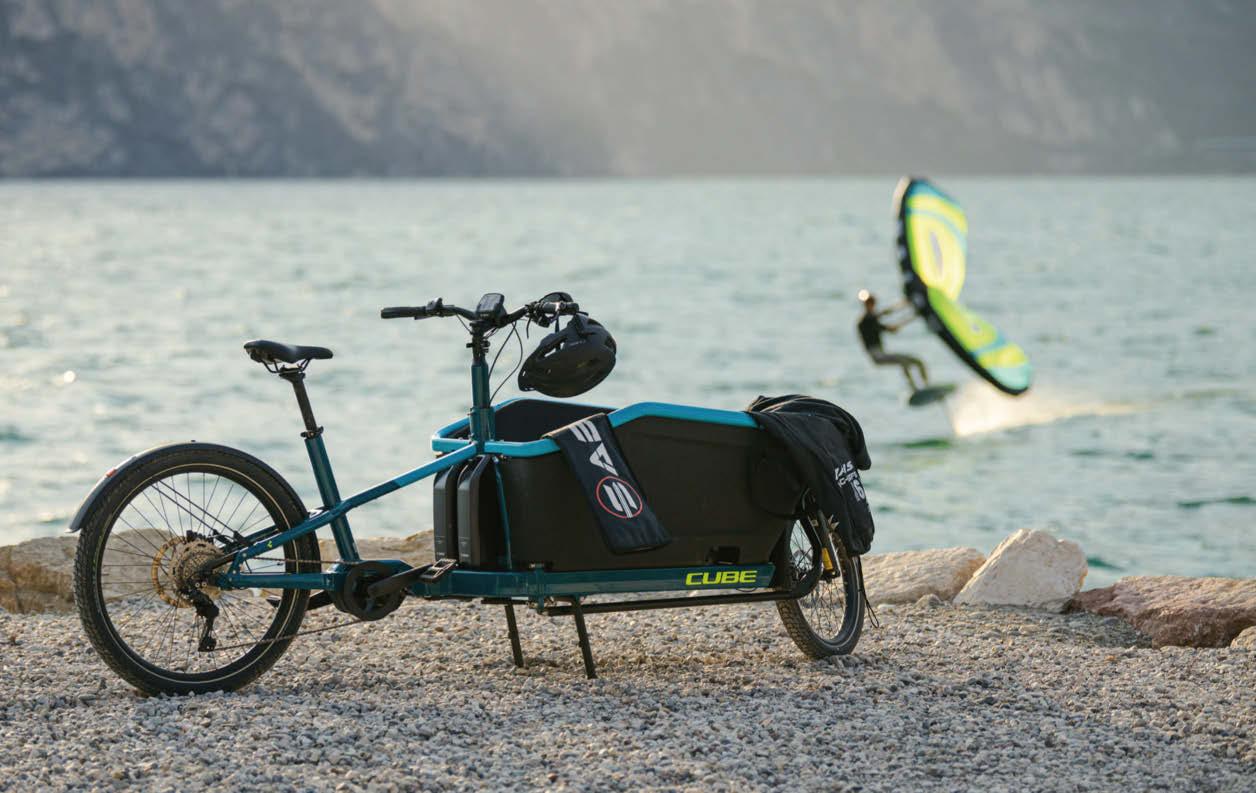 CUBE CARGO HYBRID
CUBE CARGO HYBRID
At the age of 12, British cliff-diver AIDAN HESLOP decided that one day he’d be a world champion in the sport. Now, eight years later –and armed with the two most difficult dives in cliff-diving history – he may be about to make that dream a reality
Words SAM RICHES P hotography GIAN PAUL LOZZA
ore than 20,000 people stand watching from the banks of the waterfront, the decks of anchored yachts, and the crowded balconies of high-rise towers. All eyes are on a 27m-high platform jutting from Boston’s Institute of Contemporary Art. It’s June 2022 and, at the first stop of the Red Bull Cliff Diving World Series, nine-time world champion Gary Hunt has just landed himself in first place. But there’s one diver still to leap.
Aged 20 and just starting his first full season of competition, Brit Aidan Heslop isn’t an obvious contender for the win. But for Hunt there’s a kicker: Heslop is about to attempt the most difficult dive in the history of the sport. To achieve it, he must nail four forward somersaults and three-and-a-half twists pike in the 2.8 seconds it’ll take him to reach the water – something none of the more seasoned divers watching from below have ever attempted, let alone landed.
The anticipation is palpable. The live heart-rate monitor shows Heslop’s bpm steadily rising as he stands on the platform, but – despite being under the most intense pressure of his so-far short career – the young diver has no problem listening to his head rather than his heart. He breathes in deeply, blocking out the noise around him, focussing on what he’s about to do. He starts his run-up and launches himself upwards and into a series of impossibly quick twists and spins. As Heslop hurtles toward the water, he’s folded forward at the waist, hands clasped behind his thighs before straightening out and bracing for impact, his body tensed and taut to absorb the coming shockwave. He enters the water feet-first, at a speed of more than 80kph.
Hunt begins to clap even before the judges have awarded their scores. And
when they do, they confirm what the 38-year-old diving legend already knows: Heslop is top of the podium, having secured his first-ever win in the series.
“That, folks,” announces the commentator, incredulous, “is the new generation coming in red-hot.”
In February this year, Heslop stands on a platform 20m above the comparatively calm, warm water of the Olympic Pool in Montréal, his head just a few metres from the ceiling. From this vantage point, he can see almost every inch of the sports centre – the largest aquatic facility in Canada, and one of the few places in the world to accommodate such high diving indoors. Since moving to Montréal last September from Plymouth in Devon, it’s become a second home for Heslop. “If I want to be the best I can possibly be,” he says, “this is the one place in the world where I need to be.”
The upper limit of Heslop’s natural ability is unknown even to him. Aged 16, he already had a reputation as a prodigy after his cliff-diving debut in Polignano a Mare, Italy, in 2018 made him the youngest person to ever compete in the World Series. Then his performance over the eight global stops of last year’s Series saw him take second place overall and make him the cliff diver most likely to
challenge eventual 2022 champion Hunt for the crown this time around.
Gary Hunt is Heslop’s idol and inspiration. Described by his peers as the “Michael Jordan, Muhammad Ali and Tiger Woods” of cliff diving, he’s part of the reason Heslop is where he is today. Born in Chelmsford, Essex, but raised in Plymouth, Devon, Heslop spent his youth skateboarding and BMXing the narrow, cobbled streets of the port city. He had also tried diving, inspired by fellow Plymouth native Tom Daley, but then a friend showed him a video of Hunt performing a back triple quad – a backwards triple somersault with four twists – and everything changed.
Heslop initially thought the video was fake. He’d never seen anything like it. He
”I want to dominate the sport. I want to be untouchable”
Aiming high: Heslop has his eye on first place in this year’s Red Bull Cliff Diving World Series

Drop zone: Heslop performs a dive at Polignano a Mare, Italy, in the World Series last September


“I’m very good with my limits and knowing where they are, what I’m physically capable of”
couldn’t shake the image of Hunt twisting and somersaulting through the air. The wiry and rumbustious kid wondered if he might have a natural inclination for this, the most extreme form of the sport.
The first time Heslop leapt off a 10m diving board, he knew he was hooked. It wasn’t just the adrenaline, though that was part of it, but also how quickly he progressed. With every dive, he felt himself getting better. He entered his first junior event that year, competing at a height of 15m. Not much to him now, but it felt pretty high at the age of 12.
“Diving is just something I clicked with,” he says. “From the very first day I tried it right up to now, things kind of come naturally to me. At 12 years old, I was convinced that one day I’d be a high-diving world champion.”
Heslop’s parents used to ferry him to competitions in their motorhome, his mother often moved to tears of worry as she watched her son scale ever loftier heights. But she accepted his love of it, even as it became clear it was high diving that was Heslop’s real passion. “The creativity made me fall in love with the sport,” he says. “And with high diving it’s the adrenaline. That’s a huge factor.”
He swapped his parents’ motorhome for aeroplanes as his competitions increasingly required travel to more exotic and far-flung locations. And all the while, Heslop was progressing, taking in the science of each aerial manoeuvre and transition, improving on the grace of his execution to move away from his early rep as a ‘scrappy’ diver.
“In my early days I was labelled as the scruffy guy who went for the big tricks,” he says. “I still go for the big tricks; I just make them look pretty now. The scruffiness is still sometimes a weakness, because I’m up against divers from a gymnastics background who live their life with straight legs and pointy toes. That’s not quite me; I have to put some thought into it. But when I learn a new skill, it’s like, ‘Yeah, I understand that. I’ve got it. I’ve done it.’ There’s a limit to [what you can achieve] but I don’t think I’ve hit mine yet. I’ll know where it is when I get there.”
The search for this limit has brought him to Montréal, where he’s training under Stéphane Lapointe, who he describes as the world’s best high-diving coach. Heslop lives here with his Canadian girlfriend and fellow cliff-diver Molly Carlson.
When Heslop toppled Hunt for the first time to take his first World Series win at last year’s Boston stop, Carlson secured her own maiden win at the event. “It was an amazing moment,” says Heslop. “But even when I have a bad competition, it picks me up [to see her hit] her dives the way she can. Every day we go to training together here, it’s just more motivation.”
To access the 20m platform at the Montréal Olympic Pool, divers must climb several flights of stairs, scale a ladder, then stroll a lengthy catwalk as gym goers and recreational swimmers at ground level crane their necks and gawp.
Up on the platform, Heslop bounces on his toes with the assurance of someone still on solid ground. His lithe frame, built for speed and agility, belies his physical strength, evident in the explosiveness that launches him into the air. He pushes off the platform with his back to the water, a small crowd watching him from the poolside. Heslop seems to float for a moment, his body parallel to the pool far below him, before twisting and somersaulting into position in the blink of an eye. His entry into the water reverberates throughout the facility like a small explosion, mixing with audible gasps.
“I think something I have that a lot of others don’t is complete self-confidence,” he says as he stands by the pool, dripping, wearing a characteristic smile, “and the willingness to try dives right on the limit of what I’m physically capable of.”
But this willingness is currently being tested: having executed the dive awarded the highest degree of difficulty score in his sport’s history, to progress Heslop must now find a way to beat it. To that end, he’s working on a back quad
quad, which means adding another somersault and twist to an existing 5.2 degree of difficulty (DD) dive, pushing the DD score to an unprecedented 6.6. For comparison’s sake, the difficulty table for men begins at 2.8 for the required dives and previously reached a ceiling of 5.6 for the most demanding, with each twist and somersault adding 0.4 to 0.6 to the score. If Heslop nails it, he’ll be armed with the two highest difficulty dives in the world this season. And he’ll make cliff-diving history. Again. “It’s moving into new territory that no one’s ever touched, or even come close to touching,” he says. “So it’s definitely nerve-racking. I’m more nervous about this dive than the previous one, because it’s such a step up.”
Heslop’s 6.2 dive has already changed the game. The first time he performed it in competition – at the FINA High Diving Qualifier in Abu Dhabi in December 2021 – it won him gold. Then the dive cemented his place as a permanent competitor at last year’s World Series with his Boston win and then another in Sisikon, Switzerland, leaving Hunt in second place on both occasions. “Beating my hero and seeing him below me on the podium was surreal,” says Heslop. “Not many people get to do that.”
It seems the rest of the pack has yet to catch up. “I believe he’s still the only athlete in the world who can physically achieve this dive,” says high-diving head judge Olivier Morneau-Ricard. Meaning Heslop could compete in 2023 with that same weapon in his arsenal and stand a good chance of becoming champion.
But Heslop’s motivation is pushing himself and his sport to new heights. The way he sees it, the top divers have been pulling off the same dives for years and operating in a bubble of difficulty that he’s ready to burst. “Learning new things and having fun is what it’s all about, I think. I just want to do the biggest dive, pushing my own limit and [those] of the sport.”
According to Morneau-Ricard, Heslop has all the tools to do just that. “[Aidan] has aerial awareness that is out of this world,” he says. “It’s a gift. To get to the point he has, that young, it’s not normal. At the moment, he’s still missing a dive here and there in competition. But with age, more experience and practice, I don’t think anyone will be able to beat him any more.”
The world-class facilities in Montréal are a possible game-changer when it
“In my early days I was labelled as the scruffy guy who went for the big tricks”


 Signs of descent: Heslop plunges from the daunting 20m diving platform at the Montréal Olympic Pool
Signs of descent: Heslop plunges from the daunting 20m diving platform at the Montréal Olympic Pool
comes to honing Heslop’s already impressive skill set. Compared with competing outdoors, where divers must account for wind, rain, birds, crowd distractions, and what is often a cold sea churning below them, landing in the pool in Montréal – even from 20m – is a cakewalk. “The water’s so warm you just kind of cut through it,” Heslop says. “The hardest water for us is cold salt water, because that’s the densest. Here, the impact is not so bad.”
The pool’s unique set-up – it also features 18m, 15m, 12m and 10m platforms – can be traced back to Lysanne Richard, a high-diving world champion and former Cirque du Soleil performer. In 2015, the facility was heavily renovated and the 18m platform was installed at her suggestion. Richard saw an opportunity to modernise the building and support a growing sport. About two years later, the 20m platform, which is competition height for women, was bolted into the roof.
Now, Heslop trains at the sports centre three days a week, with two days a week spent at another pool, about 20 minutes away. He also weight-trains three days a week, conducts extensive video analysis, practises in a foam pit, and does trampoline work where divers develop the reflexes to land perfectly, feet first, every leap.
This packed schedule is evidence of a dramatic transformation in the sport in recent years. The environment in which Heslop is developing is very different to the experience of divers like the 38-year-old Hunt. “High divers [training back then] didn’t have access to coaches,” says Morneau-Ricard. “They didn’t have access to facilities, to personal trainers, nutritionists, psychologists. There was no funding.”
Heslop is now part of the first group of international high divers training together at the same place. Rather than training in isolation, which has been Hunt’s preference, this new generation of divers are working together to propel themselves and the sport into a new era. “Having six people here who are worldclass athletes and pushing their limits every day just makes you try harder,” Heslop says. “It’s a bit of competition.”
The group of six is led by Lapointe, one of only a small number of cliff-diving coaches in the world. The Canadian first met Heslop when the Brit was 18, and he says he’s seen huge leaps in the young
diver’s focus since then. “It used to be that every time he stepped on a tower he wanted to do a dive for fun,” says Lapointe. “But now he’s more mature in his reactions. And if he misses a dive, he’s able to come back and hit the next one. A year and a half ago, he would be more up and down.”
The coach says an important part of his job is providing an emotional outlet for the divers, making sure they feel secure and approach competitions with the right mindset. He calls it empathetic listening. “I need to know them. I need to know what they think and what they feel to be able to make sure they’re safe and they’re on point to perform.”
This is crucial in a sport with such high stakes. “If you do something wrong, you can seriously injure yourself and be done with the sport, full stop,” says Heslop. He says it’s a misconception that cliff divers compete without fear. Rather, fear is useful, a necessary reaction for self-preservation. “I think that fear gives you a bit of a reality check, and that’s so important in an extreme sport like this.”
Heslop learnt that lesson early on. When he made his cliff-diving debut in Italy at 16, he landed a few degrees too far on his backside and fractured his tailbone. When he first hit the water, his adrenaline overpowered any awareness of the injury, but for the next six months sitting down for more than five minutes at a time was painful. “That was an awkward one,” he says. “There’s nothing you can do for a broken coccyx.”
But even after setbacks, Heslop doesn’t need much persuading to get back up on the board. “The adrenaline is a part I love,” he says. “When you stand on the [platform] and you’ve got a new dive to learn and your heart’s going, it’s
almost like an addiction, which has always made me want to continue. But I think I’m fairly level-headed, too. I’m mentally prepared for what I’m doing. In my head, I’m going to do this dive and I’m going to be safe about it.”
It’s what’s helping him drill the back quad quad, ready for this year’s World Series. “It’s daunting doing something you haven’t watched someone else do, but I’m treating it like learning any other dive,” he says. “I’ve tried it off the 20m with one somersault less than the final dive. Now I just have to add a somersault in the middle of it somehow. I’m very good with my limits and knowing where they are, what I’m physically capable of. And I think this is within my limits – just. But it’s the hardest thing I’ve ever done.”
The first stop of the Red Bull Cliff Diving World Series is once again set to be held at Boston Seaport this June. It will mark 10 years since a wideeyed, pre-teen Heslop first watched that video of Gary Hunt, and a year since he first managed to beat him to the top of a podium. Heslop hopes this year’s Boston stop will also mark the start of a series that sees him crowned king of his sport. “To know I’m pushing the world champion at 20 years old feels great,” he says. “I really like the position I’m in.”
But Hunt isn’t in any rush to give up the mantle. He’s currently training in Dubai at DuDive, the only springboard and high-diving club in the UAE. No stranger to improvisation, Hunt has been launching himself from DuDive’s rafters as he trains for the upcoming season, toeing a narrow ledge before leaping 20m into the pool below. He’ll come with his own answer to Heslop’s challenge.
Full of the self-confidence that’s got him this far, Heslop says he’s excited to leave the warm haven of the sports centre in Montréal and get back out into the elements. The title is on his mind, but – armed with a dive that will have the designer of the World Series’ difficulty graphic sweating – from Heslop’s vantage point it’s also possible to see much further.
“It isn’t just about the world title,” he says. “I’m pushing my limits to their maximum capacity. I want to dominate the sport. I want to be untouchable.”
The 2023 Red Bull Cliff Diving World Series starts in Boston on June 3. Watch all the action live on Red Bull TV; redbull.com. Instagram: @aidan_heslop
“Diving is just something I clicked with… Things kind of come naturally to me”
Top of the world: Attar summits K2 in July last year –an icy contrast with the desert in Riyadh, where she trained
In 2022, NELLY ATTAR became the first Arab woman to summit K2. And back in Saudi Arabia, where women have long been discouraged from physical activity, she’s become a fitness role model, inspiring millions to move their bodies
 Words MAUREEN O’HAGAN
Photography TERRAY SYLVESTER
Words MAUREEN O’HAGAN
Photography TERRAY SYLVESTER


“I’ve learned through life there are plenty of opportunities through challenges”
ou might picture serious mountaineers as a grizzled bunch, but this one grooves. Nelly Attar has danced on her way up Mount Everest, her big curls bouncing wildly before reaching the summit. She’s danced on technical Ama Dablam and on mellow Kilimanjaro. She’s even danced on terrifying K2 this past summer. She’s danced when she’s happy, danced when she’s bored, and she’s danced through fear. For Attar, “movement is medicine”.
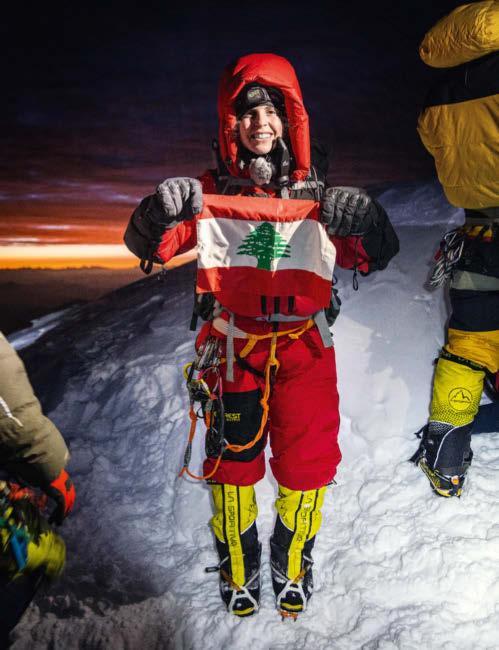
Here’s another incongruous fact: this 5ft 2in (1.57m) powerhouse trained to climb the world’s highest peaks from a home base of Riyadh, Saudi Arabia. That’s hot, flat desert, not mountain snow and ice. Then there are the rules, both written and unwritten, that for much of Attar’s life gave most women and girls little access to sports or fitness – not as athletes, as spectators, or even in school gym class.
Dancing in public has also been taboo. “I’ve learned through life there are plenty of opportunities through challenges,” she says. “You just have to be creative.”
Attar’s progression as an athlete – from teaching dance classes underground and opening a wildly influential dance studio to completing marathons and Ironmans and climbing the world’s tallest mountains – is indeed a story of challenges and creativity. But that’s only part of it. Her career trajectory, from psychologist to sports figure, tells another story, too, one that reflects how life in Saudi Arabia is changing, and how Attar is helping to change it. “I shifted careers to work in sports, because in Saudi that’s what created more impact,” she says. “Especially in mental health.”
In a country where 60 per cent of women get less than 30 minutes of physical activity a week, simply moving the body can be transformative. The physical struggle – of the climb, of the marathon, of a dance class, or an hour spent at the gym – is a way to deal with life’s other trials: the losses, disappointments, self-doubt, and even the hardest of them all, grief. “It’s the best antidepressant, the best anti-anxiety pill ever,” she says. Which is the story she wants to share with fellow Saudis, with women, and with the world.
In the record books, Attar’s singular achievement to date is her climb of K2, long dubbed ‘the savage mountain’ because, as one early climber said, it “tries to kill you”. It’s a gruelling, weeks-long process that involves a long approach; an acclimatisation rotation; avalanche, weather and rock- and ice-fall hazards; and a looming serac over a steep, narrow passageway that has claimed numerous lives. Last July, she became the first Arab woman to reach the 8,611m summit. But in many ways, another first – one that won’t go in any record books – is just as significant. It involves dance.
If you live in a region where dance performances, clubs and lessons are common, and where music fans dance at concerts, this may be hard to grasp, but until relatively recently, dance and music weren’t permitted in public places in Saudi Arabia. Attar helped open the world of dance and movement to Saudis, which is why we’ll begin the story of her mountain journeys here. It started with a period of personal challenges. Moving to London in 2010 to pursue a Master of Research degree in psychology, she was plagued by anxiety – throat-constricting panic attacks that left her feeling like the world was collapsing. It took months to learn how to cope. She started with stillness, slowing her breath and focusing on just one thing. Then, for a longer-term fix, she turned to movement. “My outlet was sports: running along the Thames, fitness classes, dancing. I tried everything,” Attar says. “When I didn’t train, I wouldn’t feel good.
I’d feel lazy. When I’d start to train, I’d feel better, want to take care of myself more, eat better.”
After graduating, Attar looked for work in London, then in Lebanon, where her father lived, but the job hunt went on for more than a year. In 2013, she finally found work back in her hometown, Riyadh, providing therapy for brain injury patients. But then she had another challenge. In Saudi, women like Attar had few outlets. The few existing fitness options open to women were mostly poorly equipped gyms connected to beauty salons. An Arab woman jogging in public was unusual enough to draw comments. So was simply being outdoors without an abaya – a long, black, robe-like dress. But she knew she had to move.
So she had the idea of offering female colleagues dance lessons after work. It was a scary prospect at first, but the move “changed my career and, later down the line, my life”. As the classes became more popular, she began travelling around the city, to embassies and other private venues, teaching dance underground. Her mother and stepfather had another intimidating idea: she could open her own studio. This was 2017, and it was a risk. That year, a 14-year-old boy was detained after doing the ‘Macarena’ on a city street. There was no clear path to get a business licence. Some conservative elements couldn’t accept the idea of women doing anything athletic. She could be in trouble if discovered. She wasn’t even sure if she was a good-enough dancer. “I did one thing consistently right,” she said in a 2021 TEDx talk. “Regardless of how it looked, I took that imperfect step forward.”
She named the studio Move. Open only to women and girls, it offered everything from Afrobeat to belly dancing and hip hop. But learning dance steps was
only part of the appeal. Women would arrive early just to bask in the warm, supportive environment. Girls would bring their mums, who would hang around to watch, learn and socialise. On the side, Attar was organising other activities for the larger community, too – hikes, running events, anything to get women moving. “There are infinite possibilities. Basketball, dance, playing with your kids. Movement is such a big umbrella. You have to go and see what works for you. Unconsciously you’ll start to build.”

She saw it in the twentysomethings who found confidence through movement. She saw it in the conservative mums who took up belly dancing at Move. “It was like a party, really,” Attar says of the scene. Students became “a tribe, a community. Their whole emotional wellbeing changed”. She remembers one teen who was so shy when she walked through Move’s door, she could barely speak. Through YouTube, the girl had learned some dance moves and convinced her sceptical mother to allow real lessons. At her first class, a one-on-one with teacher Noura Al-Abdulaziz, the girl was shaking. All she could do was nod and try to follow the steps.
Al-Abdulaziz understood. She had once suffered a paralysing depression, but “I started communicating with people through my body, through dancing, not saying one word”, she says. “That’s how I got healed.” Now, she watched her struggling student do the same: “She found her own style, her own personality.” Now a creative director, choreographer and dance teacher working all over the country, Al-Abdulaziz says, “Move started the idea that dance is something fundamental we need here in Saudi. I feel like I’m truly healing the Saudi people through dance.”
Only those who risk going far can find out how far they can go – this was something Attar’s father, Mohamed, said often. When she was younger, he took her on hikes, which wasn’t common in her region, but he loved exploring the outdoors. “We’d come across a beetle and he’d tell me about it,” she recalls. “He opened my eyes to nature.” When she was 17, he took her to Africa, where they climbed Mount Kenya. They didn’t summit, but a seed was planted. When climbing, Attar “just blossoms”, says her sister, Rasha Attar Elsolh. “She looks her best, feels her best, does her best. She’s meant to be on a mountain.”
Mohamed Attar wasn’t just her father, he was her best friend. They spoke by phone many times a day, and his words became a fuel for her climbing. She ticked off more peaks: Kilimanjaro, Elbrus, Aconcagua, Island Peak. Still, the first time someone suggested

“Movement is the best antidepressant or anti-anxiety pill ever”
Mount Everest, Attar thought it was absurd. How do you train in the desert for the world’s tallest mountain? Then she thought about her father encouraging her to push her limits, about how meeting challenges makes you stronger, and she took that imperfect step forward. Training for an arduous climb is never easy, but in Saudi Arabia there are additional challenges. Because there are no snow and ice-covered peaks, she ran intervals on sand dunes. To build strength, she dragged tyres through the streets. To dodge the desert heat, her workouts began at 3am. To avoid attracting attention from the moral police, she jogged in her black abaya. Finding the highest elevation gain in
Riyadh – about 150m – she trudged up and down for hours at a time. Attar’s training drew some stares. But it also had a hidden benefit: “People have said to me, ‘That’s how you’re so strong mentally.’”

In 2019, as her group – Attar, other Arab women climbers, plus trained guides and Sherpas – made their way from one high-altitude camp on Everest to the next, she’d listen to encouraging voice messages from her father. After spending two months on the mountain, they reached the summit.
Not long after, Attar suffered a series of personal losses. First, the pandemic hit Move and wound up crippling the business (though she has hopes to reopen one day). Then, in October 2020, Mohamed Attar died of COVID. In one fell swoop it felt like she had not only lost her father but also her way forward. “I felt my heart was open and it was leaking, like a fountain I couldn’t close,” Attar recalls. She couldn’t eat, couldn’t sleep. Seeing friends, dancing, training… it all felt impossible. And yet she knew what she had to do: move.
“Starting to teach dance changed my career, then my life”
In autumn 2021, Attar announced a plan to climb K2 the following summer. It was a dangerous goal: only around 400 people had summited it at that point, and statistics showed that one climber died for every four who stood on top. So she amped up her training, enlisting Mike McCastle, the US coach who trained explorer Colin O’Brady for his unsupported Antarctica trek. “He’s a brilliant coach,” she says, lauding the creative ways he pushed her limits, not only building strength but unearthing weaknesses.

By this time, Saudi Arabia was changing, too. The government was pushing a modernisation plan, Vision
2030. In 2016, it had established a women’s branch of its sports authority. The government also agreed to license female gyms – a reaction, in part, to alarming obesity statistics. In 2017, live music was no longer prohibited. In 2018, women were given the right to drive and to attend certain sporting events. In March 2022, Riyadh had its first official marathon, where men and women ran together. Many more women were going without the abayas that impeded physical activity. The government even began sanctioning concerts where men and women danced together. “I didn’t think all this could be happening so quickly,”
Attar says. “It’s just amazing, so surreal. The country changed, and we were part of that change.”
Attar was also becoming more widely known. Several publications wrote about her. Strangers recognised her at running events. She was tapped to be the first trainer in Saudi’s Nike Training Club. The Saudi Sports for All Federation appointed her as an official ambassador. The government had partnered with Move and Attar to provide a free boot-camp programme as a public-health measure, and also to teach dance to schoolkids. She had tens of thousands of followers on social media. And yet, when she sought
sponsors for her K2 climb, she couldn’t get traction. Though she’d spent almost all her life in Saudi, she was a Lebanese national, which made Saudi brands less receptive. It also became clear local companies still weren’t sure what to do with a female fitness icon. “I’ve had brands tell me they can’t work with me because I am Lebanese; because I dance too much; because I’m a woman, yet I don’t dress ‘feminine’ enough; because I have too many passion activities; because I can’t fit in a box,” she posted on Instagram.
Finding sponsors was exhausting. But then she recalled her father’s words on moving forward. She drained her bank account and made the plan anyway. Right before her departure for Pakistan, Bateel, a dried-fruit brand, agreed to support part of the cost of her trip. Incongruous, maybe, but her spirits were buoyed: “That’s why you should never give up.”
Not long after, she found another partial sponsor, digital media brand Yes Theory. As Attar began the seven-day trek from the village of Askole to the base of the mountain, she thought about the thousands of women and girls she’d supported through dance and fitness, and how they, in turn, were supporting her. She thought about her family back home, cheering her on. “I have a whole tribe of people climbing with me,” she realised. When the team spent two brutal weeks waiting out a storm at camp, Attar danced away the stress and boredom, infusing strangers’ tents with her energy even as she understood the tough journey ahead. Looking up at the endless snow and ice, she knew trusted guides would show the way. She also knew she’d have to take every step to the top herself.
Sometime after 10pm on July 21, they set off in pitch-black darkness. All the training had paid off: her legs and her lungs were up to the task. But, as her headlamp glared against a forbidding wall of ice, she faltered. Training in Saudi, there was no way to master ice climbing, yet here she was facing an ice wall on the world’s most dangerous mountain. Struggling for purchase with her crampons, she slipped again and again, at one point swinging perilously on her rope. Suddenly, for the first time in years, she was engulfed in throat-closing panic. Breathe, she told herself. Focus. Filter everything else out. “I’ve already been through grief, the worst thing in the world,” she realised.
Her heart slowing, she kicked her right crampon into the ice and made a move. She kicked in her left and made another. Around 3.30am, she cried as she reached the top. And when the team returned to camp, around 10 hours after starting, everyone danced.
“I’m Nelly Attar,” she likes to say, “and I move for a living.” nellyattar.com

“It’s amazing. Saudi Arabia changed, and we were part of that”
 Words ALEX KING Photography CARLOS BLANCHARD
Words ALEX KING Photography CARLOS BLANCHARD
It’s the car racing series that’s hit the motorsport world like a bolt of lightning. And now, channelling pure electricity to save the future, the WORLD RALLYCROSS CHAMPIONSHIP is accelerating so fast it’s leaving Formula 1 in the dust


Inside the garage of the Hansen Motorsport team, AC/DC is blasting out of the speakers as mechanics speed through final tweaks to their cars. The Swedish team’s drivers, Timmy and Kevin Hansen, are amping up to head out onto the track; the latter is honing his reaction times by darting around and smashing at BlazePods – flash-reflex training devices – arrayed across a table.
With their matching clean-cut hairstyles and boyish faces, the two are clearly brothers, Kevin discernible by his glasses and a sheen of stubble. At 24, he’s six years Timmy’s junior and the more gregarious of the pair. Kevin currently sits in fourth place in the World Rallycross Championship, but he has
a palpable desire to match the success of his elder brother, the 2019 champion, who’s ranked number two this season. Timmy, meanwhile, is going through race data on a laptop with the team manager, who also happens to be his father, Kenneth Hansen, a former European Rallycross champion.
Rallycross, as the name suggests, has its roots in rallying. But back in the 1960s, before drone footage and dash cams became commonplace, the format – individual cars running against the clock over a lengthy point-to-point course across multiple days – was a hard sell to TV audiences. In 1967, Robert Reed, a producer of recently launched ITV programme World of Sport, had an idea: multiple cars duelling it out on a mixed-terrain circuit of asphalt and gravel. Easy to film and exciting to watch, with fast races over five laps, it was a concept tailor-made for TV. On the morning of Saturday, February 4, 1967, the first rallycross race was aired. Within a year, it was attracting almost 10 million viewers.
The sport also proved a hit with rally drivers across the world. In 1969, the first Dutch and Australian rallycross events were held, and a full European Championship was born in 1973. In 2010, the US debuted the RallyCar Rallycross Championship. Then, in 2014, the Fédération Internationale de l’Automobile (FIA) – motorsport’s preeminent governing body – launched the World Rallycross Championship (World RX). But the sport’s dramatic evolution didn’t stop there. At the end of the 2021 season, it was revealed that the World RX Championship would go fully electric.
It’s November 2022 at the Nürburgring motorsport circuit in the German district of Ahrweiler. Spectators are packed around a small, closed section of the legendary track called the Müllenbachschleife, here to witness the final round of this first electric season.
“I was caught, in the middle of a railroad track. Thunder!
I looked round, and I knew there was no turning back. Thunder!”
 Time for focus: Timmy Hansen prepares for the race start; (opposite) Johan Kristofferson and teammate Ole Christian Veiby battle it out
Time for focus: Timmy Hansen prepares for the race start; (opposite) Johan Kristofferson and teammate Ole Christian Veiby battle it out

Breaking up the asphalt straights are gravelled corners. Switching between the two surfaces adds drama to each lap, the asphalt sections boosting top speed while the loose gravel creates unpredictability and often chaos as the sliding cars throw up clouds of dust, wreaking havoc on the visibility of drivers in pursuit. Each race takes less than three minutes, with onboard cameras showing many drivers don’t even blink from start to finish.
Five cars are lined up on the grid, waiting for the green light. As they hurtle off the line, any doubt about their electric capabilities evaporates in a split second. The acceleration is blistering. These cars can hit 100kph in less than two seconds – faster than an F1 car – and the sound is unlike anything you’ve ever heard: an otherworldly chorus of high-pitched whooshing, almost hydraulic, like Optimus Prime flexing his robotic muscles.
Standing by the first corner, you’re treated to a multilayered sonic picnic in high definition: the rise and fall in pitch of four-wheel-drive electric powertrains decelerating and accelerating again; fibreglass bodies crunching against one another; tyres ripping up dirt as they jostle furiously to exit the bend, and finally the impact of all the gravel spraying into other cars and the safety barriers. The only sound missing is the roar of internal combustion engines. But without this layer to drown out everything else, your ears receive more information, not less. Speed, acceleration, visceral contact – all these aspects are amplified. It’s a complete sensory experience in every way.
Alittle later, outside the pits, another head-to-head competition between the drivers is underway. Volvo Construction Equipment, one of the race series sponsors, and supplier of the electric recovery vehicles that unceremoniously pull disabled cars off the track, has set up a battery-powered compact excavator with a metal rod hanging from its hydraulic arm. The challenge is to dip it, in sequence and against the clock, into five stacked piles of tyres. Johan Kristoffersson jumps into the cab. But, rushing through the last tyres, he causes the pole to swing wildly, preventing it from lowering easily into the holes.
“What’s my time?” he shouts. “That’s no good. Let me go again.” On his third
attempt, he completes it in 33 seconds, a score he seems happy with. Only then does he step out of the cab, grinning broadly. Kristoffersson is not a man who likes to come second, as evidenced by the five World RX Championship titles he’s claimed in the nine years the competition has been running. After taking the 2021 crown, the Swede has dominated this season in his Volkswagen Polo RX1e, winning seven of nine meets before arriving at the Nürburgring this weekend. His victory in the prior round at Circuit de Barcelona in Catalunya has already sealed this year’s championship, making him the sport’s first electric
world champion, but Kristoffersson is determined to stamp his authority over the final meet of the season.
“I’ve been extremely competitive for as long as I can remember,” the Swede says. “Victory means a lot to me.” It’s an attitude seemingly at odds with his selfdeprecating demeanour; tall, with short blond hair, the 34-year-old looks more like a tech start-up whiz than a ruthless racer. But appearances can be deceiving: “Every hour I put into becoming a more complete driver is because I want to win. The day that doesn’t mean much to me is the day I’ll do something else. I wouldn’t be able to maintain the motivation required to get results.”
Kristoffersson’s competitive nature became apparent as early as the age of seven – first in cross-country skiing with his father Tommy as his trainer, then in racing for Kristoffersson Motorsport, the family team owned and managed by Tommy, who won the Swedish Rallycross

“You can really see the power of electric on a rallycross track”
Kevin Hansen
Championship three consecutive times between 1990 and 1992. From six months old, Kristoffersson rode in the team bus with his father, travelling from race to race around Europe. “After all these years, we’re used to giving each other the breathing space we need,” Kristoffersson explains. “When times are tough, we know how to give support. We know what to say, and when not to say it.”

Having exhausted their fun with the excavator – Tommy also gave it three goes before quitting, frustrated with his 48-second best time – the two are now back in the Kristofferson Motorsport garage, trawling through the data collected by the car’s sensors and onboard video feed, pinpointing any mistakes that might be improved upon. The atmosphere is focused and intense, with digital countdown timers ticking away beside each car as mechanics rush to make repairs and adjustments before the next race. But there’s also an air of satisfaction. While Timmy Hansen clocked the fastest lap in practice, Kristoffersson delivered when it really
mattered, coming top in the SuperPole shoot-out, a single timed lap that decides the grid positions for Heat 1, something he’s achieved every round this season.
“One of my priorities was to be fastest in the SuperPole, and that makes it 10 out of 10,” he says, jubilantly. “It’s always nice to be fastest over one lap, where it’s all about pure pace.”
If it isn’t clear yet, Rallycross is very much a family affair, and the Kristofferssons and Hansens are its two biggest dynasties. Johan Kristoffersson and Timmy Hansen have been sparring for the best part of a decade now, sharing the World RX crown between them for the last six years. But it’s a legacy that goes back far further than this generation. Between 1989 and 2008, Hansen’s father, Kenneth, won
14 European Rallycross titles, a tally unlikely to be surpassed. When he started his own team, Kenneth turned to the best teammate he knew: his wife.
Susann Hansen is a rallycross superstar in her own right, winner of the 1994 European Rallycross Super 1400 and still the only woman to hold an FIA European Rallycross title. She raced while pregnant with Timmy, and after he was born he would ask other toddlers, “Where’s your mechanic?”, believing the typical family structure to be mum, dad and mechanic. Today, Susann is a vital presence in the Hansen Motorsport garage, not just for the tasks at hand but also with an eye on the sport’s future. “Electric technology is expensive, and this is the biggest investment Hansen Motorsport has made since our foundation in 1990,” she says. “But we need to stretch our wings and move for the next generation.”
Then there’s Svend Hansen, Timmy and Kevin’s late grandfather. In 2002, he invented a key feature of the modern sport that ensures whoever leads out of the first corner isn’t guaranteed the win. Adding a few torturous seconds to the circuit, the joker lap is a detour from the main course that every driver must take once per race. Which lap they choose to do that offers tactical advantages (do you get it out of the way early, or attempt to build a lead and swallow that pill later?), and each driver has a dedicated radio spotter to relay when best to go for the joker. It brings an air of unpredictability to every race and makes for touch-and-go moments as drivers frequently risk collision to be first at the convergence point.
After his fastest time in the SuperPole, Kristoffersson also claims victory in Heat 1, Timmy Hansen tearing at his heels on both occasions. For his efforts, Hansen earns pole in Heat 2, Race 1. As the cars roll off the jacks for the start, Tommy, Kenneth and Susann are already in the observation booth overlooking the track with the other team managers.
But Hansen’s starting position proves a double-edged sword. A lack of grip on the deteriorating surface allows his brother Kevin and Finnish driver Niclas Grönholm to emerge from the second corner ahead of him. Kevin Hansen is flying and, after taking his joker on the final lap, blazes back onto the track comfortably ahead of Timmy and across the finish line. Kristoffersson, on pole
RX is a family affair, the Kristofferssons and Hansens its two biggest dynasties


With its short, sharp races, RX is the perfect test bed for electric technology

for Race 2, suffers a similar fate: locked behind his Norwegian teammate, Ole Christian Veiby, his windscreen takes such a beating from the dust that vision becomes impossible. He finishes second, behind Veiby, with Grönholm’s teammate Klara Andersson taking third place.
Andersson may not have come first, but she’s a leading light in the sport. The 23-year-old Swede, who was racing go-karts at the age of seven, made her rallycross debut in 2018 and went on to win the 2150 category of the Swedish Rallycross Championship in 2021. The teaming-up of Andersson and Grönholm this season has generated headlines for being the first gender-equal line-up in World RX history, but it’s still very much a male-dominated field. Andersson is the competition’s only full-season female driver and, in fact, the only woman in any top-tier FIA world championship in 2022.


To win the Swedish Rallycross title in 2021, Andersson had to overcome 55 male competitors, and, two months before arriving in Nürburgring, she made history in Portugal by becoming the first
woman to step onto a World RX podium. “Many people doubted me joining the championship as it was such a big step,” she says of the journey. “I have so little experience compared with some of these guys. I’m proud I’ve proved I belong at this level, and my pace has been developing, but I want to start beating them.”
In the Kristoffersson Motorsport garage, the team are poring over the reigning champion’s car, hoping for some valuable data on how it performed when stuck in traffic behind Veiby, but its radiators have taken quite a battering, dripping liquid all over the floor. Both will have to be replaced as the timer counts down for Heat 3. This provides a great opportunity to peek beneath the bonnet of one of these electric beasts. Gone are the turbocharged, two-litre, four-cylinder engines of the 2021 RX1 cars, replaced by the new RX1e’s two electric motors – one for the back wheels and one for the front – delivering a combined output of 500kW (equivalent to 680 brake horsepower) and 880Nm of
“People doubted me… I’m proud I’ve proved I belong at this level”
Klara AnderssonPower surge: one of the Hansen Motorsport Peugeots leads the pack at this corner of the Müllenbachschleife; (below) Swedish driver Klara Andersson; (opposite) the Hansens sign autographs for fans of their team
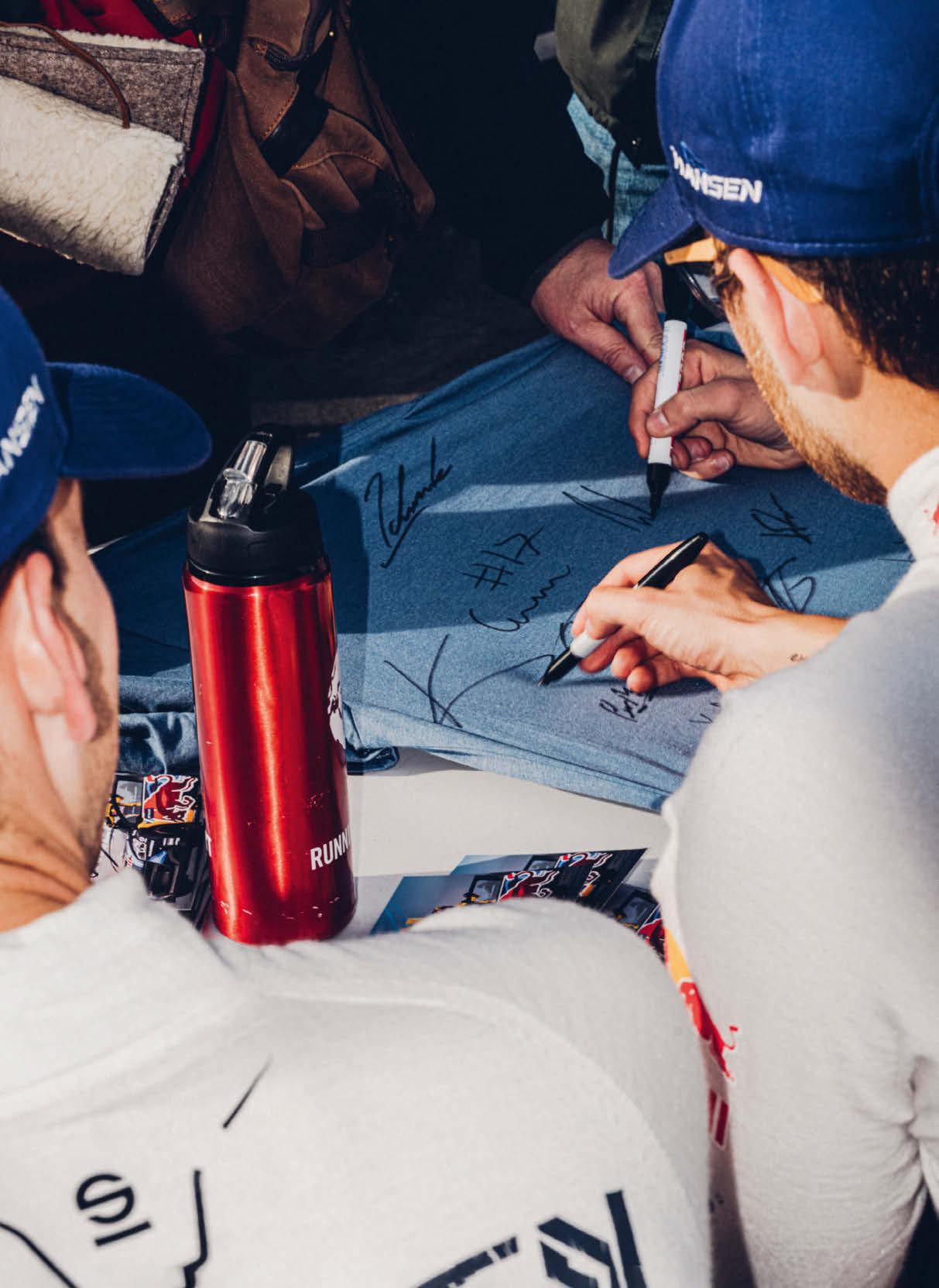
torque. It’s this last statistic, capable of being unlocked instantly, that delivers the F1-surpassing, sub-two-second acceleration from standstill (a current F1 car manages 0-100kph in around 2.6 seconds). There’s also a 500kW battery mounted next to the driver to distribute weight evenly through the car, and a pair of radiators and reservoirs –one for dielectric fluid, a non-conductive coolant for the battery, and one for glycol, the coolant for the electric motors. It’s these that are leaking.
Unsurprisingly, stringent safety procedures are required for working on an electric race car. As the mechanic puts on a safety visor and thick rubber gloves to connect the large red battery-charging cable, a colleague stands by with what looks like a long plastic scythe. Unlike AC current, which would fire you back across the room, DC current forces you to grip onto whatever is electrocuting you, hence the safety hook to pull the mechanic away should that happen.
But perhaps a better example of the electric power of these cars is on the track. At the World RX of Norway, in Hell
Kevin Hansen
in August, event winner Kristofferson clocked a best lap time of 38.058 seconds in his RX1e. The winner in Euro RX1 at the same circuit on the same weekend, Andreas Bakkerud, driving a petrolpowered car, logged a best lap time of 38.069s – a fraction of a second slower. When you consider that petrol RX1s have had more than three decades of development and are at the peak of their evolution, and the new electric cars were taking part in the first race weekend of their debut season, the potential is clear.
“You can really see the power of electric on a rallycross track,” says Kevin Hansen. “It’s already faster in a straight line and those speeds will just rise and rise.” With its short, sharp races, rallycross is the perfect test bed for this technology – without concerns over

range or battery life, the drivers can focus on pure performance, pushing every kilowatt out on the circuit.
Sponsors clearly agree. The Hansen Motorsport cars carry logos for the United Nations’ Race to Zero and Global Goals campaigns, and they’re the first rallycross team to sign on to the UN’s Sports for Climate Action initiative. “We felt it was our responsibility as a team to use the platform we have to showcase electric cars and highlight environmental issues,” Hansen says.
As well as being a driver, Hansen is the team’s chief marketing officer, implementing their vision for a more sustainable future. This includes cutting down on travel by servicing the cars at the paddock after a race rather than taking them back to HQ, always flying economy, and reusing everything they can. This has earned Hansen Motorsport the FIA’s Three-Star Environmental Accreditation, the highest level of recognition awarded.
“We’re not just adopting electric on the technical side but undertaking a broader transition to a sport with fewer emissions,” says Hansen. “We want to prove that a small group of people can create a winning team with sustainability at its core. That’s key to attracting sponsors who want to invest in something sustainable and spectacular.”
As you might imagine in a sport whose enthusiasts are labelled ‘petrolheads’, the transition to electric has not been without its detractors. A glance at Reddit – that bastion of calm, reasoned debate – from before the season yields a few well-constructed opposing views: “They fast as hell but an absolute snooze fest to watch.” “That sounds like a massive RC car.” “Put loud speakers on it but it’s just a dude making car noises.”
“There’s no roar with electric. Hearing is one sense of the spectacle and we’ve changed that, so you need to respect fans’ responses,” acknowledges Hansen. “But without the engine revving, they can better understand what’s happening and what the driver goes through. We need to bring the fans closer to us so they can get more involved and see how fantastic the technical side is. Sport that is unsustainable has no future. And electric is more interesting and exciting.”
It’s notable that as Hansen is talking, the music of this season’s unofficial
“Sport that is unsustainable has no future”
anthem band, AC/DC, is once again playing in the garage. “I need a pickme-up. A rollin’ thunder truck… Yeah, electric sparks. A shot in the dark.”
Day two at the Nürburgring, and Johan Kristoffersson is feeling pretty good: his restored Polo having won Heat 3 yesterday and Semi Final 1 today, he’s in pole position for the Final. Timmy Hansen won Semi Final 2, earning second on the grid ahead of qualifiers Kevin Hansen and Veiby. The fifth spot was secured by Andersson, but in a controversial decision by her team, they’ve substituted Grönholm in her place, as, with more championship points, the Finn has a shot at finishing the season in the top three. Call it karma, or the joker, but things here never pan out as you’d expect.
Kristoffersson powers off the line and into the lead, Grönholm ramming him from behind through the second corner. The two stick to each other like glue until both take the joker on the final lap. Kristoffersson emerges from the detour first, then Kevin Hansen suddenly appears from nowhere, sliding ahead of Grönholm to take second. It earns the younger Hansen enough points to steal third place in the championship from the Finn. The strategy of swapping out Andersson seems not to have paid off for Grönholm’s team.
Timmy Hansen comes fourth, securing Hansen Motorsport a phenomenal second and third place for the season. But the winner of the weekend is Kristofferson, solidifying his championship crown with eight victories out of 10. Later, as the teams pack into a pit garage for celebratory drinks and end-of-season goodbyes, the Hansens are nowhere to be seen.
Their team garage is empty, the cars and equipment already packed into the trucks. Only Kevin and Susann remain, but their smiles, too, have disappeared. Post-race scrutineering by officials has identified an incorrect suspension arm mistakenly fitted to Kevin’s car that
didn’t meet regulations. He’s been disqualified, dropping him to fifth in the championship and gifting Grönholm the third place he coveted. Racing as a family team means you share the highs together, but also the lows. Mother and son console each other.
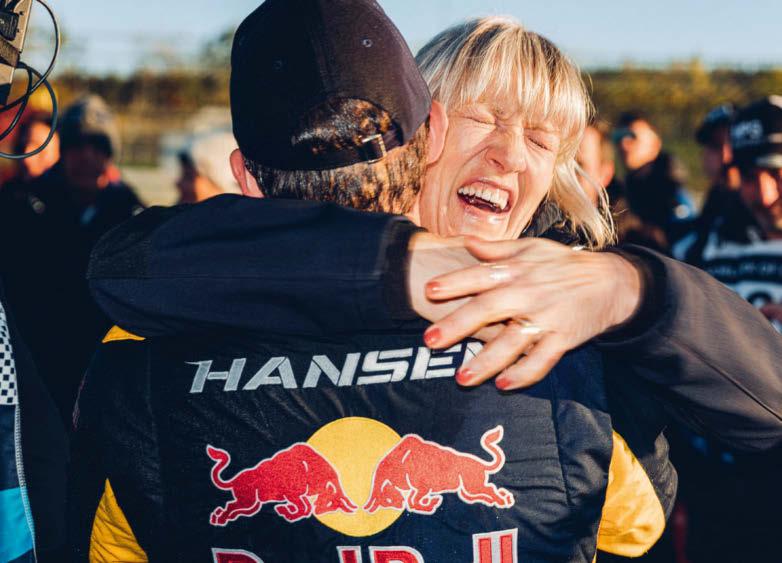
“It’s frustrating that a small mistake can have such a big impact, but that’s racing,” says Kevin, philosophically. The first electric season of World RX was always going to impose a steep learning curve on the teams, but everything seemed to have gone right for the Hansens, until the very end. “This season was always about getting to grips with this new technology, learning as much as we could and preparing for what comes next,” he adds. “Everything we do as a team, and as a family, is with our eyes focused on the future.”
In other words, there’s always next year. Or, as a wise man once sang: “Yeah, it’s alright. We’re doin’ fine, fine, fine. Thunderstruck.”
The first round of the 2023 World Rallycross Championship takes place in Hell, Norway, on June 17-18; fiaworldrallycross.com
“Everything we do as a team is with our eyes on the future”
Kevin Hansen
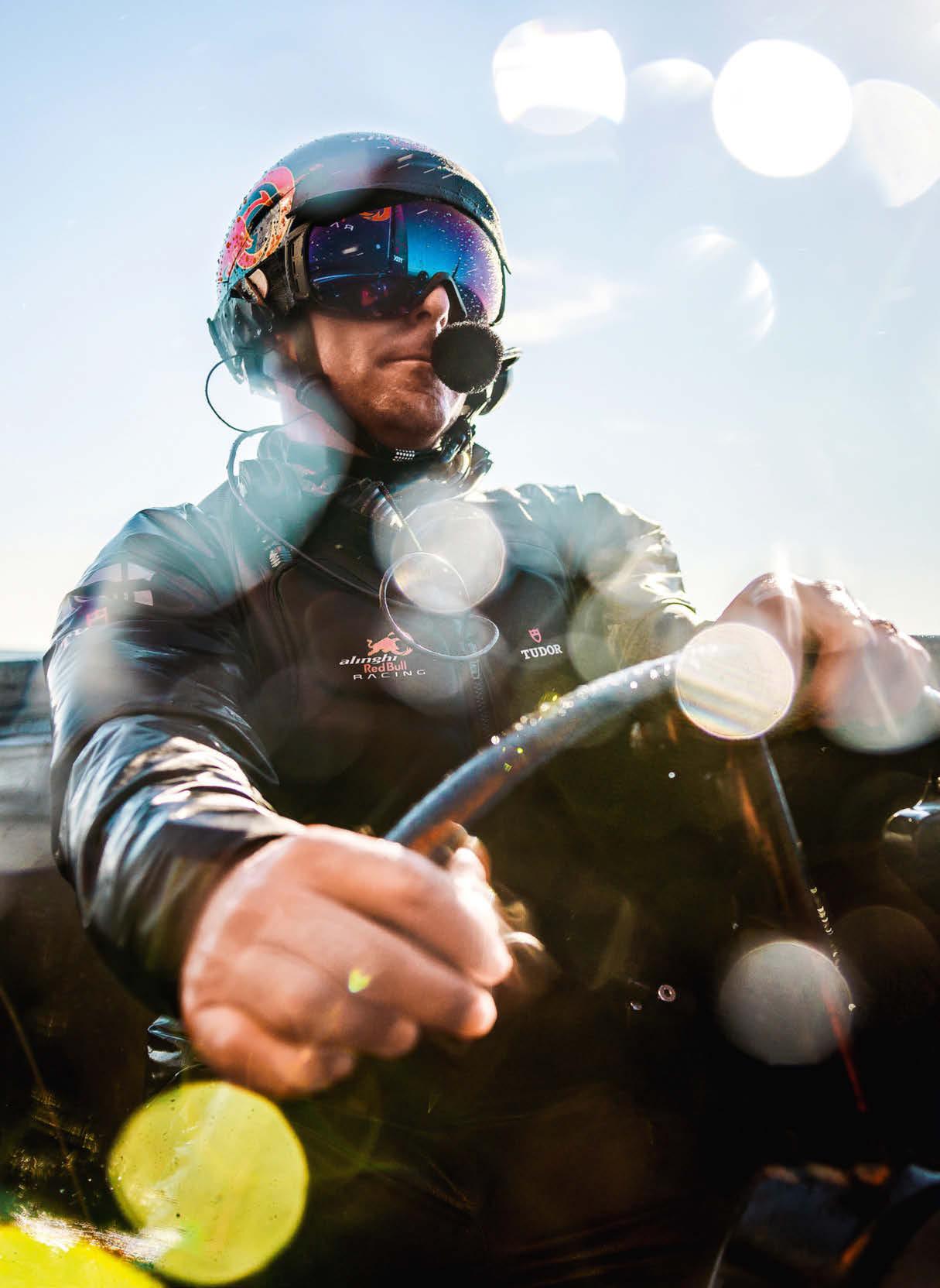
Introducing the most vital component of the world’s fastest, most technologically advanced racing yachts: humans
 Words ANDY RICE
Countdown to the AMERICA’S CUP
Words ANDY RICE
Countdown to the AMERICA’S CUP
The America’s Cup is the pinnacle of yacht racing. It’s also a case study of contradictions. Founded in 1857, it’s the world’s oldest sailing competition still in existence, but at the same time it’s a contest pushing the possibilities of modern boat design and performance. Onboard the AC75 vessels – aerodynamic 22m-long monohulls featuring sailing hydrofoils – are computers that manage the foils and hydraulics. But protocol dictates they can’t be automated; instead, each state-of-the-art yacht must be entirely operated by its human crew. This symbiosis of the cybernetic and the organic has a name: a cyborg.
In a straight-line drag-race, a fully automated, unmanned AC75 would more than likely outrun its eight-man counterpart. So, when it comes to adding humans to the mix, you need the fittest, smartest crews available. Some are selected for their exceptional muscle and aerobic capacity – they’re the engine room. Others are there for their mind, not least their ability to make difficult decisions in the blink of an eye.
But there’s also a point where the ‘human factor’ may have the edge over currently existing computer systems. Once the huge sails harness the wind and the boat reaches more than 18 knots, the hydrofoils generate enough lift to raise the 6.5-tonne hull out of the water. At this point, the drag resistance of the water drops to a fraction of what it was, and the AC75 accelerates in excess of 40 knots. Now, the boat is balancing on a knife edge of control and the sailors must react to the demands of maintaining stable flight. The sails require adjustment, known as ‘trimming’; the angle of the foils call for split-second positioning to keep a level footing above the water.
Each member of the eight-man crew must focus on their aspect of the boat yet also be tuned into each other’s priorities. Perhaps the closest analogy isn’t drawn from another sport, but something else. “It’s like an orchestra,” says Pietro Sibello, sailing advisor for Alinghi Red Bull Racing (ARBR), the Swiss team entering the 37th America’s Cup in Barcelona next year. “Each instrument complements the other, coming in and out of the music exactly on time and on pitch.”
To better understand this harmonious relationship between human and human, and human and machine, The Red Bulletin spoke with members of Alinghi Red Bull Racing team about what it takes to be a living component of an AC75 racing yacht.
As the name suggests, these crew members control the steering and ride-height above the water, constantly adjust the sails for maximum speed, and make tactical decisions about positioning on the course and how and when to engage the opposition.
HELMSMAN
Their primary role is to steer. Linked to everyone via audio comms, the helmsman is often the skipper who calls the shots, initiating and coordinating manoeuvres.
At 24, Maxime Bachelin (pictured opposite) is Alinghi Red Bull Racing’s youngest potential helmsman. He first sailed at the age of eight, in a tiny 2.4m dinghy known as an Optimist. More a box-on-water, it’s a far cry from the sleek AC75 that Bachelin is now mastering, but the fundamentals of good

helmsmanship all stem from those formative years. “The Optimist teaches you the feel for a boat,” says the Swiss sailor. “You learn how to see the wind on the water, and you develop a sixth sense for the environment around you.”
From there, he moved up to 4m-long dinghies with two members of crew, learning the importance of communication and developing a neartelepathic understanding between himself and the others. That’s fine at 10 knots, but at 50 the freedom to discuss tactical options is
in shorter supply. This is why sailors such as Bachelin train their reaction time much like F1 drivers do. “We spend hours in the simulator, practising situations we’ll experience in racing,” he says. “And there are exercises we do, timing our reaction to changing lights. Anything to speed up reaction time helps us do a better job on the water.”

Traditionally, there’s only one helmsman, who switches sides of the boat between two rear steering pods (see illustration overleaf) while the flight controller temporarily
takes the controls. But in 2021 the Italian Luna Rossa team innovated with two helmsman – one on each side. As Sibello, a former Luna Rossa strategist, explains, “Running across the back of the AC75 when it’s foiling through a manoeuvre at speed can risk the possibility of falling overboard.” The Italians’ approach reduces that likelihood, but it creates a new problem: who is in control at any given moment? It’s a communications conundrum with pros and cons, which is why ARBR has yet to commit to either option.
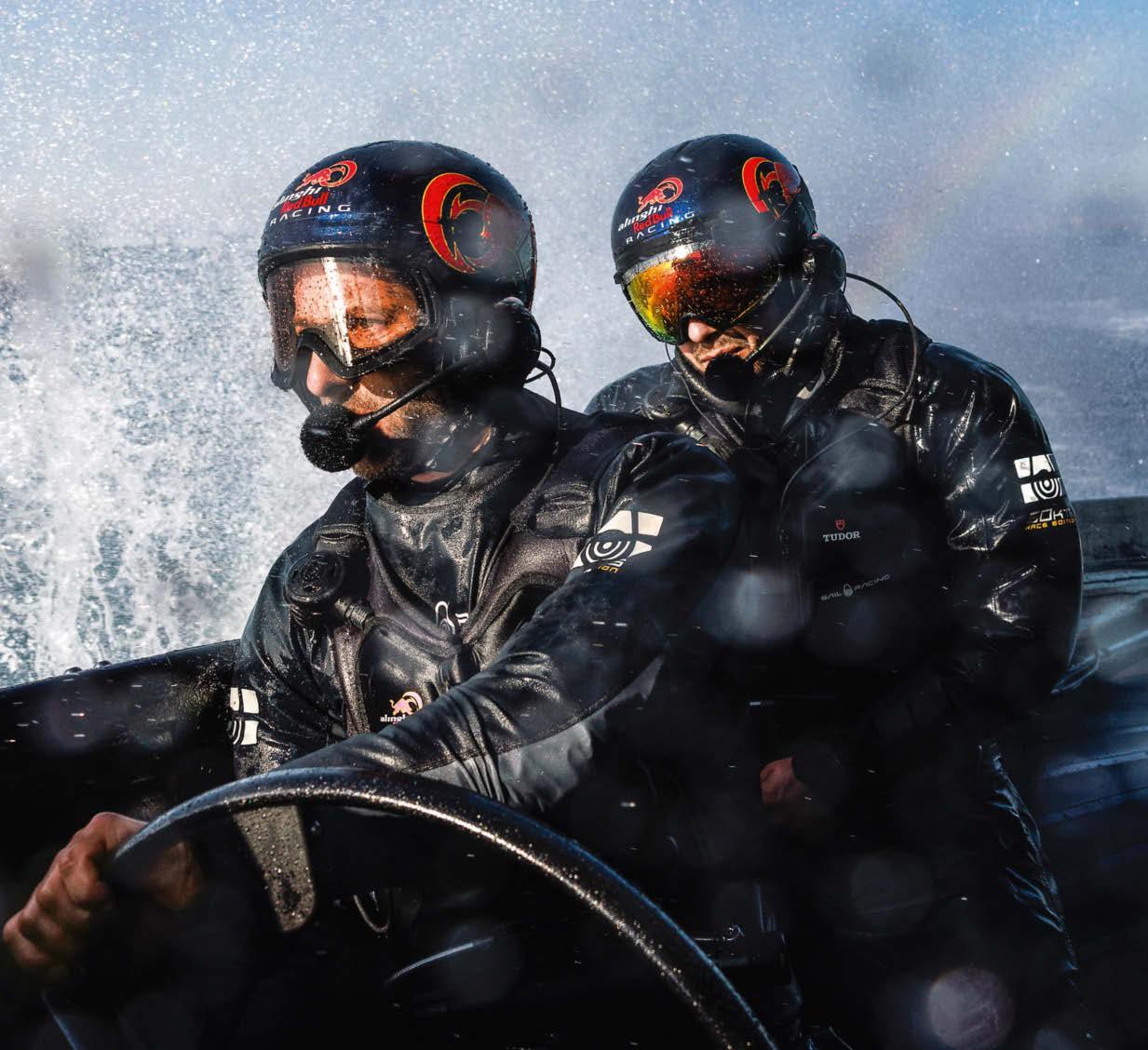 Team goals: Maxime Bachelin at the wheel of ARBR’s AC75, with Arnaud Psarofaghis
Team goals: Maxime Bachelin at the wheel of ARBR’s AC75, with Arnaud Psarofaghis
“Faster reaction times help us perform better”

For the 2024 America’s Cup, crews have been limited to eight (in 2021, it was 11). This calls for a creative distribution of duties, and the teams are still looking for that secret sauce. As such, the roles you seen here are not representative of ARBR or any of the other teams.
A quick lesson in sails. The 145sq-m doubleskin mainsail combines with a smaller 90sq-m sail at the front of the boat, called the jib. These are the source of wind power on an AC75. Between them is a gap known as ‘the slot’, which air passes through. How the sails are trimmed determines how efficient this air flow is. It’s a complex science, but when the sails are properly trimmed, the interaction between the two produces far more forward power than the sum of the two sails working independently.
Trimmers manage this relationship between the sails and constantly control the shape of the mainsail for optimum balance and speed. In lighter winds, they put depth into the sails, but when the AC75 transitions to foiling mode (flying above the water), drag from the sea is suddenly reduced and the boat is overwhelmed by the power in the sails, so the trimmer rapidly narrows the profile of the mainsail to cut through the wind.
Meanwhile, the flight controller manages the angle of the foils on each side of the boat. Most of the time, only the leeward foil is in the water, with the windward one lifted, counterbalancing the wind against the sails. During low-speed manoeuvres, both are in the water, which provides additional lift. Sailing in flat water doesn’t require so much moment-to-moment calibration, but choppy water calls for constant adjustments.
Bryan Mettraux (pictured right) is training for the roles of both flight controller and mainsail trimmer in the
ARBR team. “It helps with understanding how your job fits with others on the boat,” he says. “And it’s better to have people capable in more than one role.”
Although he can’t recall for sure, Mettraux thinks he started sailing before his first birthday. “My dad used to take the family out on his cruising boat,” says the Swiss sailor, now 32. “Then I started racing in a 420 [a 4.2m-long training dinghy].” His first high-level competition came when he joined a race training centre and started the kind of one-on-one match racing that defines the America’s Cup. “I sailed a lot on the GC32 [a hydrofoiling catamaran]. It’s not as fast or refined as the AC75, but that’s good for improving reaction time.”
Where trimming is concerned, Mettraux says that it’s a 50/50 split between gut instinct and on-screen data. Over time, he expects it to become more of the former. After all, data is recent history; sensing what will happen in the near future is more valuable in the heat of the moment. “Sometimes you feel what the boat needs,” says Mettraux.
The boat’s muscle. Their vast aerobic reserves and physical strength – measured in wattage – must be constantly converted via manual winches into power for the vessel’s hydraulics. The more wattage, the more precisely the Driving Group can trim the sails, as ARBR crew members Nils Theuninck and Augustin Maillefer explain…
Traditionally, this group has been called ‘grinders’ as the handles they use – to power the winches that trim the sails and move the boom – look and sound like enormous coffee grinders.
However, all that changed in the 2017 America’s Cup, when Emirates Team New Zealand (ETNZ) secretly developed a pedal-powered boat using cyclists on deck-mounted ‘exercise bikes’ called cyclors. Not only could their legs generate an estimated 20 per cent more wattage, it also


 1. Helmsman
2. Helmsman
3. Flight controller
4. Mainsail trimmer
POWER GROUP
5. Trimmer/grinder or cyclor
6. Trimmer/grinder or cyclor
7. Grinder or cyclor
8. Grinder or cyclor
1. Helmsman
2. Helmsman
3. Flight controller
4. Mainsail trimmer
POWER GROUP
5. Trimmer/grinder or cyclor
6. Trimmer/grinder or cyclor
7. Grinder or cyclor
8. Grinder or cyclor
‘Trimming’ is a 50/50 split between gut instinct and on-screen dataAC75 CREW POSITIONS



freed up their hands to help control the sails.
Nils Theuninck is driving himself to higher levels of strength and fitness to help power the AC75’s engine room. At 1.94m tall and weighing 91kg, he says it’s all about building up his power-to-weight ratio.
The 26-year-old is wellpractised in this regard, having spent his formative sailing years competing solo in a heavyweight 4.5m Finn, a dinghy requiring both brute force and intelligence. In 2021, Theuninck topped the Finn World Rankings and won bronze at the European Championships, and he’s determined to do his country proud in the America’s Cup. “You race against the best sailors in the world on the most advanced boat ever created,” he says.

Augustin Maillefer used to hate the wind. In his previous sport of Olympic rowing – he represented Switzerland at the 2012 and 2016 Games – it was the enemy. Now, as a member of ARBR’s Power Group, he’s learning to love a good breeze. “My experience in rowing means my body is conditioned to perform through pain.”
Synchronisation in rowing is paramount, says Maillefer, but the symbiosis of teamwork on an AC75 is far higher. “In rowing, you don’t waste energy worrying about the others in the boat; you just focus on bringing the best of yourself,” says the Swiss athlete, who turns 30 this April. “In sailing, we’re more aware of how each other’s roles affect the overall performance and what we can do to make all our jobs easier.
In 2017, ETNZ won the America’s Cup. Leg power was then banned in 2021, but it’s back for the 2024 Cup. The Swiss ARBR team are tightlipped about whether they’re going ‘arms’ or ‘legs’, but all eight of the Power Group are including cycling in their training regime.
While the abilities of the crew are essential to winning the America’s Cup, they couldn’t succeed without a vital ground team. Here, we meet a few…
Andrea Emone (pictured above) is responsible for managing the telemetry data collected by the many sensors positioned around the AC75.
“I was campaigning in the Olympic windsurfer class, but I also studied aerospace engineering and took a master’s degree in computational fluid dynamics (CFD),” she explains. Studying two mediums – air and water – while having realworld grounding in sailing gives the 26-year-old a rare insight into the data she sees.

Also, while it’s against regulations to allow a computer to control the boat’s systems during a race, it can be beneficial during training sessions. “In the [2021] America’s Cup, we saw autopilots used to practise situations where the PLC [programmable logic controller] could move at speeds a human can’t follow,” she says. A crew member can then replicate the computer’s behaviour.
Emone’s expertise also puts her in an authoritative position to opine on that prickly subject of whether the AC75 is even a boat in the truest sense at all. “It’s not a plane, and it’s not a traditional boat either,” she says. “Sailing has always relied on generating lift, but with sails in the vertical plane. The AC75 also does that in the horizontal, lifting out of the water. But it’s still a boat.”
One, it should be noted, that’s capable of travelling at more than eight times the speed of the Wright brothers’ Kitty Hawk when it pioneered powered flight in 1903.

A computer can process thousands of calculations in a second. A human being? Perhaps one or two. This, says Pietro Sibello (pictured below), is why a computer does a much better job of flight control than a person.
“Sailing an AC75 is like piloting an aeroplane,” says the 43-year-old Italian sailor. “But because the data isn’t automated, you have to share the work between the crew. They need to be perfectly in sync.” There’s that orchestra analogy again.
“Computers can be more precise, quicker in reaction time, and it’s true that having all the systems automated would make the boat faster in many situations. Where a human is going to be better is having experience of race situations, anticipating moves, seeing gusts [of wind] on the water. Over time, you could develop [an automated] solution for that as well, but it would take longer. A human would still win a race. For the time being, anyway.”
To read more of The Red Bulletin’s America’s Cup stories, scan the QR code and head to redbulletin.com
“In 2021, autopilots practised situations that a human can’t follow”

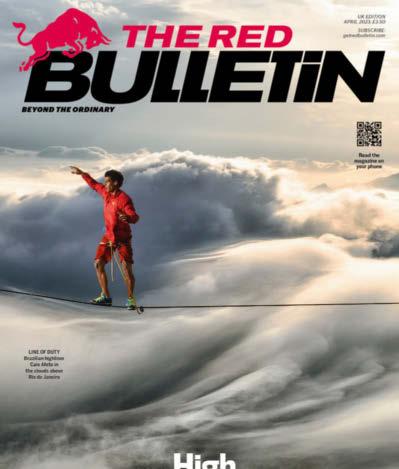







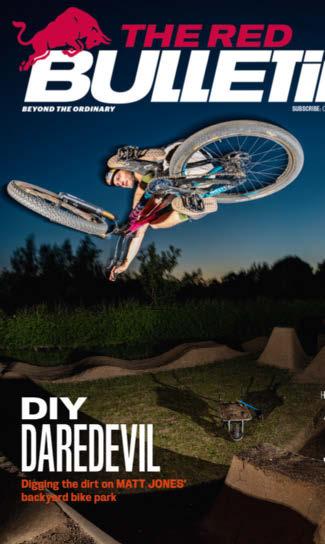
The next issue is out on Tuesday 9 May with London Evening Standard. Also available across the UK at airports, universities, and selected supermarkets and retail stores. Read more at theredbulletin.com



HIGH CAMP
Big-wall climbing (and sleeping) in Chamonix, France

My eyes flicker open to a glowing band of light.
As sleep slowly lifts, I see the horizon, jagged like shark’s teeth and black before the dawn. Before it, a golden tide lapping at the silhouette of these 3,000m peaks. Rolling over in my sleeping bag, I peer over the rim of the portaledge – a fabric platform just a metre and a half wide, suspended like a tiny shelf on a towering wall of sheer granite plunging hundreds of metres before being swallowed up by the nothingness.
This is what multi-day, big-wall climbing looks like up on the rocky pinnacle of Le Brévent, the 2,525m cliff that rears up over the west of Europe’s adventure capital, Chamonix. Less than 24 hours earlier, I was on solid ground, 500m below, at the gondola lift station of Planpraz, staring up at the intimidating edifice of stone cloaked in swirling mist.
I’ve signed up with the Arc’teryx Alpine Academy for my first taste of bigwall climbing – a long, multi-pitch ascent too vast to be tackled in a single day, and requiring the use of a vertical, makeshift camping ground. My guides are top-level alpine athletes in their own right. One of them is Arc’teryx ambassador Paolo

Marazzi, whose helmet bears the motivational slogan ‘You’ll die’. More of a coaching aid than a promise, it’s used by Marazzi to underline the consequence of badly tied knots or fluffing safetycritical big-wall procedures. Up there, any unsecured fall is fatal.

We pack stuff sacks with sleeping bags, food, water and the portaledges. The bags are far too heavy to climb with, so they’ll be clipped to the rock beside us, then unclipped and hauled up once the leader reaches an anchor point above. This is an art in itself, as another guide, Frédéric Degoulet, shows me. Stepping into a nylon loop attached to the rope, I must use my bodyweight and the lat muscles in my lower back to pull, hauling the bag upwards. It’s a real workout and an energy-sapper.
Ready to go, I tie my harness into the rope. My climbing partner, qualified IFMGA (International Federation of Mountain Guides Association) guide Johanna Sullivan, sorts her gear: slings that can be used as additional anchor points or extenders; blocks of metal on wires and camming devices that anchor into cracks in the rock, and carabiners to clip our rope into. I’ve rock-climbed before, but I’ve never slept up a rock face or taken on a big wall. I try not to let fear seep into my cold, tense muscles.
After checking each other’s knots, we approach a vertical rock garden amid green eruptions of moss. It’s not too steep at first, so we climb together, Sullivan stopping to loop the rope over boulders and provide security as I follow her up. Soon, the gradient sharpens – we’re the only signs of life on this steep grey barricade. Up above, isolated upward cracks in the rock look like a waterfall trying find the path of least resistance, except in reverse. Sullivan sets up an anchor before setting off up one of the cracks, leaving me tied to the other end of the rope to belay her from my harness, so that I can take her full weight and catch her if she falls.
The quickest route to Chamonix is to fly to Geneva and take the train, or transfer to the town itself by road in a shared minibus

“As the fingertips of my leading hand stretch out, the back of my anchored hand slips out, jolting my toe off the sloping foothold below”
Matt Ray, adventure journalist
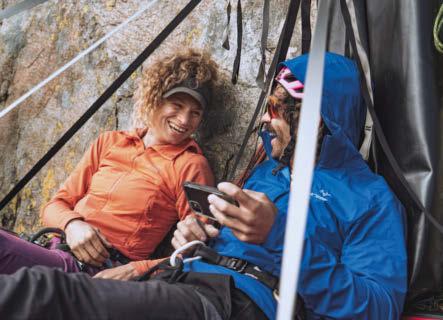
Soon enough, I follow her up the fault line. The mist closes in. I can’t see the ground or summit, and sounds are muffled. It’s as if the universe has shrunk to a 50m space. I realise we’re totally committed.
My hands search above me for a hold that fits my fingertips and feels secure enough to pull on. The rock is cold, and the only good edge I can find is slanted sideways, but I know it’s not going to snap. I lock my fingertips into it, curling my thumb over my first finger and angling my body so that I can pull in a straight line while pushing up with my legs. I learn quickly that working with
the rock, pulling in the direction it wants you to, is the best way to climb.
A couple of moves later, I run out of edges, but I spot a gap deep in the crack. Although its sides are smooth, it’s the perfect size for a hand jam – a move where you expand the volume of your hand in a gap to create an anchor point. Just as the fingertips of my leading hand stretch out for an inviting square block, the back of my anchored hand slips out, jolting my toe off the sloping foothold below. I let out a yelp, but I’m saved from a fall by my leading hand, which drops gratefully onto the edge above.
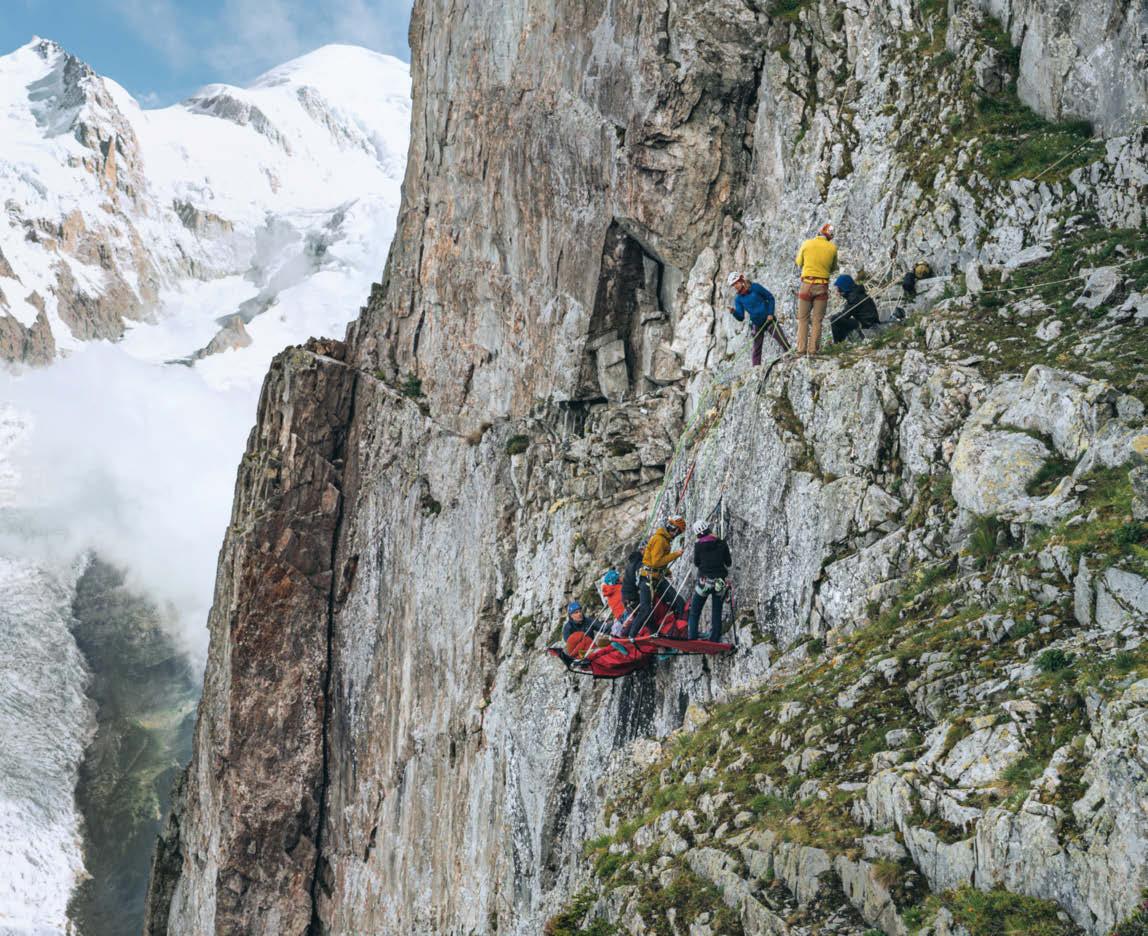
A sharp spike of adrenaline rushes through me. I’ve scraped a fair amount of skin off the back of my jammed hand. It’s a lesson in needing to be fully committed – I didn’t trust the secureness of the hold enough, relying too much on muscle power.
After reaching Sullivan, I find myself hanging in space on my harness, both feet braced against the rock, while she sets off once more, leaving me to juggle loops of rope. The clouds part to reveal the peak of Mont Blanc across the valley, huge glaciers reaching down its face with fingers of ice.
A couple of hours of relentless ascent later, we reach the final pitch for the day. But there’s no time to relax – setting up camp is a mission in itself. Hanging in our harnesses with a sheer drop below, my portaledge buddy and I struggle with the unruly bundle of poles and straps that will become our bed for the night.
The Arc’teryx Alpine Academy is an annual four-day mountain masterclass – the biggest educational event of its kind in the world. It features skills clinics for every level of climber from beginner to expert, covering everything from ice-axe and crampon training to mountain first aid and rescue, glacier navigation, vertical photography and multi-day big-wall portaledge sessions. There are workshops with some of the biggest names in the sport, areas to test out gear that’s still in R&D, and the festival’s hub includes a bouldering wall, DJs and musical performances. It returns to Chamonix from June 29 to July 2. Tickets and the full programme can be found at chamonix.arcteryxacademy.com
It’s a trial of patience, and once it’s assembled we learn the importance of communication; both of us standing at once will capsize the portaledge, dumping us into space. We’ll be sleeping in our harnesses.

As the sun begins to set, I tuck into a meal straight out of a plastic pouch, watching alpine birds flying overhead to roost. The mountain quietens as I sip Côtes du Rhone from a camping mug that our guide stashed in the haul bags.
Letting out a long breath, my feet dangling into the void, I realise that this is the most privileged spot in the valley right now. Dehydrated curry never tasted so good.
Matt Ray is an action-sports and adventure writer and photographer who has climbed mountains everywhere from Scotland to Rio de Janeiro. He blogs at adventurefella.com; Instagram: @adventurefella




It sounds like the stuff of dreams: a way to drop off instantly. US athletics coach Lloyd ‘Bud’ Winter documented the process in his 1981 book Relax and Win: Championship Performance in Whatever You Do, calling it a ‘military method’ as it was supposedly developed by the US Army to help soldiers sleep anywhere, any time. Then, last year, Canadian fitness coach Justin Agustin rediscovered the technique and shared it with his 1.9 million followers on TikTok. Agustin boldly claims that after six weeks of practice 96 per cent of people were able to fall asleep within two minutes of shutting their eyes.

This is the method: starting with your forehead, gradually relax your muscles from head to toe while slowing your breathing and clearing your mind by thinking of a relaxing image. If the latter doesn’t work, repeat the phrase ‘Don’t think’ for 10 seconds.
While there’s a distinct lack of supporting science, the technique does have some merit, concedes British sleep expert Dr Lindsay Browning. “It’s similar to other things I teach, such as progressive muscle relaxation or slow, deep breathing,” she explains.
But why does it work? And what if you’re one of the unlucky four per cent still awake long after 120 seconds have passed? Here are some eye-openers for you…
“The reason we don’t sleep is because we’re anxious,” says Dr Browning. “Our body is keeping us alert to a threat.” It’s a primal survival instinct that kept our prehistoric ancestors alive but is still hardwired into humans. The stresses of modern life cause the same biological reaction, quickening our breathing and increasing our heart rate to “pump oxygen around the body so we can fight or run away”. Countering this requires a shift in focus.
Having trouble grabbing 40 winks? Here’s a military-grade hack, no sheep required
“These techniques are about reducing anxiety; faking calmness until you are calm. When we consciously relax our body and slow our breathing, it lowers our levels of cortisol [the ‘stress hormone’], which slows everything down.”
Repeating the phrase ‘Don’t think’ may replace the thoughts you’re having, but Dr Browning thinks it isn’t enough: “If you’re really that stressed, you need something meatier to distract your brain.” She recommends visualising yourself in a relaxing environment and overloading your mind by imagining all the different sensory experiences you’d be having. “I describe it as like putting on a VR headset – the processing power needed to maintain that complex image is huge. There’s no room to think about tomorrow’s exam.” But this technique can’t just be fired up at midnight, she adds; it requires practice throughout
the day. Finally, a legitimate excuse for daydreaming.
Sleep cycles are key to a good night’s rest. Each lasts around 90 minutes – we have four-tosix per night – during which we move between light and deep sleep. Diphasic sleep, where we experience wakefulness in the early hours, is another sleep pattern inherited from our forebears. “[In prehistoric times,] being unconscious for eight hours was dangerous.
Nowadays, we don’t want to be awake for two hours at 4pm, so we go to bed later and wake earlier, putting pressure on that sleep to force it into one block.”
International travel is a surefire way to unsettle our 24-hour sleep-wake cycle, known as the circadian rhythm. To minimise jetlag, Dr Browning advises that as well as wearing an eye mask and earplugs, you stay hydrated and “accept you won’t sleep brilliantly on a plane; even a little is enough”. Eating meals in your destination’s time zone also helps, although she admits that travelling west is always easier than east: “Our bodies like going to bed and waking up an hour later.”
Dr Lindsay Browning is a chartered psychologist, neuroscientist, sleep expert and author of Navigating Sleeplessness: How to Sleep Deeper and Better for Longer; troublesleeping.co.uk

“It’s all about reducing anxiety, faking calmness”
Dr Lindsay Browning, sleep expert
In the late 1980s, another certainty in life was added to death and taxes: you will lose at Tetris. It’s now hard to appreciate just how huge this puzzle video game was. Bundled with the Game Boy in 1989, it’s the reason why Nintendo’s handheld became the fourth best-selling console of all time. It remains the highest-selling game ever, with 520 million sales across more than 65 platforms. And last month saw the premiere on Apple TV+ of a Tetris movie, about Soviet software engineer Alexey Pajitnov’s battle to secure the rights to his creation during the last years of the Cold War.
What makes Tetris so enduring is its shockingly simple gameplay. A series of ‘tetrominoes’ (shapes made of four square blocks) appear at the top of the screen and each must be guided as it descends. It can be moved from side to side and rotated before it reaches the bottom, the aim being to create unbroken horizontal lines that disappear when completed, making the rest of the grid drop, scoring you points and speeding up the game. In the background plays a catchy 8-bit version of the Russian folk song Korobeiniki, better known these days as ‘the Tetris tune’. But allow the screen to fill with incomplete lines and it’s game over.
The game has also coined another phrase: ‘the Tetris effect’, where the thoughts, visual images and even dreams of long-term players start to take the form of blockshaped patterns. Studies into this phenomenon suggest it can have positive benefits, including improving brain efficiency and spatial skills, thickening grey matter (the outer layer of the brain, responsible for cognitive processes such as memory retention), and even preventing PTSD symptoms.
“Some people are arranging boxes and start
Can the world’s most enduring puzzle video game improve your brain? Here’s how to master ‘the Tetris effect’
thinking about [techniques] from Tetris; others close their eyes and see squares while trying to fall asleep,” explains Dr Angelica B Ortiz de Gortari, a Swedish psychologist who more broadly categorises this as ‘Game Transfer Phenomena (GTP)’, which encompasses all instances of spontaneous mental and physical behaviour that are a direct result of video gaming.
So, how can Tetris turbocharge our processing abilities? And what if we can’t shift the illusory lines appearing before our eyes?
Why is Tetris the focus of so much GTP research? “It’s very simple, people get it [quickly], and you can play it very easily,” says Dr Ortiz de Gortari. However, before you fire up that vintage Game Boy, she points out the phenomena


isn’t exclusive to Pajitnov’s puzzle game. “Candy Crush, for example, provides similar experiences, although you don’t have the rotations. Tetris uses more cognitive resources because of [these].”
Skills developed for clocking high scores in Tetris can also have real-world applications – for loading the dishwasher, perhaps, or parking your car
in a tight space. “The way we play can influence how we perceive our environment,” Dr Ortiz de Gortari says. “It’s an automatic procedure to apply strategies to real-life contexts.” It may also indicate increased brain efficiency. In 1992, Dr Richard Haier, a professor at the University of California, noted that scans of first-time Tetris players’ brains showed high cerebral glucose metabolic rates (GMRs) – their brains were burning a lot of energy. But after four to eight weeks of play, while gaming performance improved, GMRs had dropped to normal levels.
Dr Ortiz de Gortari’s studies have recorded 30 different manifestations of GTP, from hallucinations such as seeing health bars above people’s heads, to earwormlike audio sensations. These experiences, she says, are caused by real-life events that are similar to “important repetitive elements in the game”. She has also noted people “seeing, hearing and feeling their fingers moving long after they’ve stopped playing”. Fortunately, in most instances, this isn’t a cause for concern: “It’s a normal phenomenon – 75 per cent [of players] experience GTP at some point.”
Too much GTP, however, can be problematic. For example, some have intrusive thoughts at night where their mind becomes a Tetris grid, says Dr Ortiz de Gortari, or, in extreme cases, people might “think someone is shooting outside their window”. If the Tetris effect is affecting your life, there are ways of averting an episode: “We can’t prove how you can reduce it, but we know that playing music and trying to do something else can distract you.” The movie Tetris is available to stream now on Apple TV+; tv.apple.com
“The way we play can influence how we see the world”
Dr Angelica B Ortiz de Gortari

Scrolling to success, or streaming snake oil? Navigating the workout wormhole that is FitTok

Bulging biceps. Washboard abs. Toned glutes. Want the secrets to all these in just 30 seconds? That’s the premise of fitness TikTok –aka FitTok – where an endless stream of gym bros and bunnies offer training tips that once would have cost a fortune and months of hard sweat. One of the social media platform’s most popular content genres, the #FitTok hashtag has more than three million posts and 49 billion views.
Part of the appeal is that there’s always a new fitness trend, well, trending, and celebs are often the spark. A five-second clip of Harry Styles doing Reformer Pilates – a machine-enhanced version of the strength and stability workout – sent its popularity into the stratosphere, while people went wild for Miley Cyrus’s battle ropes, burpees and glute bridges from her recent Flowers music video. And feeds are filled with the likes of the gruelling 75 Hard Challenge – exercising twice

a day for 75 days – and the more manageable 12-3-30 Workout, where you walk on a treadmill at a 12-per-cent incline at 3mph (around 5kph) for 30 minutes.
But you’ll also come across ‘influencers’ with questionable qualifications, demonstrating dubious exercises such as ‘ultimate triceps training’ and ‘the secret to growing your glutes’. Here, personal trainer and fitness author Alice Liveing shows how to exercise caution when working out which wonder workout is for you…

Heard of the ‘treadmill strut’ TikTok trend? Here’s how it works: you walk on a treadmill while listening to a playlist and increase the speed by 0.1mph every time the song changes.

“With my personal-training hat on, I might think, ‘Is it really going to help?’” says Liveing.
“But if someone starts doing some form of movement because they’ve seen a trend on TikTok, that’s also great.”
There are bonus points for accessibility, too: “Most of us can walk, so the barrier to entry is pretty low.”
While FitTok can be great for inspiration, Liveing warns us to be wary of “anyone who speaks in extremes, overpromises certain things
or gives a time frame” – for example, someone claiming you’ll lose “X amount of weight in X number of weeks” or saying their way is “the best way”. And if someone claims their rock-solid abs are from sit-ups alone, “that’ll be a lie, unfortunately”, says Liveing. “Visible abs come from having a low percentage of body fat on your torso. You can definitely train to be more defined, but for them to be visible the body fat has to go. With social media, we need to question anything that doesn’t seem right.”
“Understand the context of where [someone else is] at and where you’re at, and be realistic,” says Liveing. “[Just] because someone does a full plank with their knees off the floor doesn’t mean that’s necessarily where you’re at with your strength.” She recommends filming yourself or using a mirror to see if part of your movement is different from how it’s supposed to be, or finding an easier version of the exercise. But, most of all, if you experience any kind of discomfort while following a video, “it’s probably not right”.
“The difficult thing is that the [TikTok] algorithms celebrate thinness,” explains Liveing. But it’s also important to remember that “genetics play a huge part in how we look”, and A-listers will have “teams of nutritionists, dieticians, surgeons and massage therapists” to help them get to that place: “To say that exercise is the [only] reason why is completely false.” Liveing follows a diverse range of people so as not to only see creators who fit the ‘fitness mould’. “Fitness can look lots of different ways,” she says. “Find people who make you feel good about how you move.” alice-liveing.co.uk
“Understand where you’re at, and be realistic”
Alice Liveing, personal trainer






LAZER Coyote
KinetiCore helmet, lazersport.com;
MESSYWEEKEND
Momentum sunglasses, messyweekend.com; ENDURA SingleTrack Core tee, endurasport. com; CAMELBAK
Chase Bike Vest 50oz, camelbak.co.uk; TSG Elbowguard Chamber pads, ridetsg.com; LEATT AllMtn 3.0 shorts, leatt.com; POC VPD Air Flow knee pads, pocsports. com; ENDURA MT500
D3O gloves, Jagged socks and MT500
Burner Flat shoes, endurasport.com;
CANNONDALE
Moterra Neo Carbon 2 bike, cannondale.com

 TROY LEE DESIGNS Flowline SE helmet and Skyline shorts, troyleedesigns.com; SCOTT SPORTS Sport Shield sunglasses, scott-sports.com; FASTHOUSE Classic Cartel short-sleeve jersey and Carbon gloves, fasthouse.com; TSG Elbow-Sleeve Dermis A and Knee-Sleeve Dermis A pads, ridetsg.com; STANCE Athletic Crew socks, stance eu.com; GIRO Latch shoes, giro.com; CUBE Stereo Hybrid 140 HPC SLX 750 bike, cube.eu
TROY LEE DESIGNS Flowline SE helmet and Skyline shorts, troyleedesigns.com; SCOTT SPORTS Sport Shield sunglasses, scott-sports.com; FASTHOUSE Classic Cartel short-sleeve jersey and Carbon gloves, fasthouse.com; TSG Elbow-Sleeve Dermis A and Knee-Sleeve Dermis A pads, ridetsg.com; STANCE Athletic Crew socks, stance eu.com; GIRO Latch shoes, giro.com; CUBE Stereo Hybrid 140 HPC SLX 750 bike, cube.eu


BELL HELMETS
4Forty Air MIPS helmet, bellhelmets. com; POC Poise hoodie, pocsports. com; SIXSIXONE Comp gloves, sixsixone.com;

TROY LEE DESIGNS
Lilium shorts, troyleedesigns.com; 100% Ridecamp knee guards, 100percent.com;
MESSYWEEKEND
Speed sunglasses, messyweekend.com; STANCE Athletic Crew socks, stance.eu.com;
RIDE CONCEPTS
Livewire shoes, rideconcepts.com; NORCO Sight VLT C2 bike, norco.com
MESSYWEEKEND
Rate sunglasses, messyweekend.com;
ENDURA SingleTrack long-sleeve jersey, endurasport.com; 100% Ridecamp gloves, 100percent. com; MET Parachute MCR MIPS helmet, met-helmets.com; GIRO Havoc shorts, giro.com;

TROY
Stage knee guards, troyleedesigns.com;
SPECIALIZED S-Works Turbo Kenevo SL bike, specialized.com
LEE DESIGNSLEATT AllMtn 2.0 helmet, leatt.com;
OAKLEY Encoder Strike
Vented sunglasses, oakley.com; FIVE TEN 5.10 TrailX tee, adidas. co.uk/five_ten; OSPREY EUROPE Escapist 30 backpack, ospreyeurope. com; MILO The Action Communicator, okmilo. com; TROY LEE DESIGNS
Flowline gloves, troyleedesigns.com;
FASTHOUSE Crossline 2.0 shorts, fasthouse. com; SIXSIXONE DBO knee pads, sixsixone. com; STANCE Tundra Crew socks, stance.eu. com; CRANKBROTHERS

Mallet E shoes, crankbrothers.com;
SCOTT SPORTS Lumen eRide 900 bike, scottsports.com
Styling MARK BISHOP Photographer’s assistant HOLLY TAYLOR Bike mechanic ALF OWENNouria Newman and Aniol Serrasolses know a thing or two about navigating extreme white water – the French and Spanish kayakers have tackled some of the world’s most remote rapids, and in 2021 they teamed up for a first descent of the Rio Blanco (‘white river’), a stretch of wild water that starts at a glacial lake high in the mountains of Patagonia. This thrilling film on Red Bull TV documents their incredible expedition – including sheer waterfall drops, as seen above (Newman, notably, is the first female kayaker to drop a 30m fall) – all the way to the ocean. redbull.com

Nathan Paulin treads a fine line with his art – literally. The French tightrope walker holds 12 world records, including one for the longest highline: 2.2km from the Normandy coastline to the tidal island of Mont-Saint-Michel. Here, he’s teaming up with choreographer Rachid Ouramdane, Swiss rock climber Nina Caprez and eight acrobats to create a vertical dance extravaganza. Sadler’s Wells Theatre, London; sadlerswells.com


For almost 1,300 years, up until 1973, Fulham Palace was the country residence of the Bishop of London. Now this historic venue is playing host to an altogether different kind of ministry. This two-day series of concerts will see the Ministry of Sound Classical hold court with a 32-piece orchestra reinterpreting iconic dance anthems, before one of the cardinal duos of British dance music, Groove Armada, take over on Sunday for an evening of rapturous superstylin’. Church! Fulham Palace, London; robomagiclive.com
When Adrian Newey met Christian Horner in 2005, the former was a car engineer who’d helped Williams and McLaren win F1 championships, the latter the rookie team principal of the newly formed Red Bull Racing. Sparks flew – the good kind. In this film on Red Bull TV, the two discuss a partnership that has won them 11 world championships. redbull.com


We all run for our own reason, and the WHY I RUN podcast makes this a shared experience. Listeners at any stage of their running journey can tap into the variety of human stories we celebrate to find inspiration, motivation, and a collective sense of joy.
Listen now to the WHY I RUN podcast from Red Bull with hosts Erin Azar and Ayo Akinwolere, and get ready to join the Wings for Life World Run on May 7, 2023.

wingsforlifeworldrun.com

Editor Andreas Kornhofer
Editor-in-Chief
Andreas Rottenschlager
Editor-in-Chief DACH
David Mayer
Creative Directors
Erik Turek (manager), Kasimir Reimann
Copy Chief
David Pesendorfer
Art Directors
Marion Bernert-Thomann, Miles English, Tara Thompson Designers
Martina de Carvalho - Hutter, Kevin Faustmann-Goll, Carita Najewitz
Photo Editors
Eva Kerschbaum (manager), Marion Batty (deputy), Susie Forman, Tahira Mirza, Elena Rodriguez Angelina, Rudi Übelhör
Global Content
Tom Guise (manager), Lou Boyd
Head of Audio
Florian Obkircher
Managing Editors
Ulrich Corazza, Marion Lukas -Wildmann
Head of Publishing Management
Sara Car-Varming
The Red Bulletin is published in six countries. This is the cover of our French issue for May, which features Valentin Delluc, one of the biggest names in speedriding – a mix of freeskiing and paragliding.

For more stories beyond the ordinary, go to: redbulletin.com
Channel Management Ivona Glibusic
Editorial Director A lexander Müller-Macheck
Head of Media Sales & Partnerships
Lukas Scharmbacher
Head of Co -Publishing Susanne Degn - Pfleger
Project Management Co-Publishing, B2B Marketing & Communication
Katrin Sigl (manager), Katrin Dollenz, Michaela Kroboth, Teresa Kronreif (manager Corporate Marketing & Communications), Julia Leeb, Valentina Pierer, Stefan Portenkirchner (Corporate Communications), Bernhard Schmied, Jennifer Silberschneider, Sophia Wahl (Corporate Marketing)
Creative Services Verena Schörkhuber-Zöhrer (manager), Sara Wonka, Tanja Zimmermann, Julia Bianca Zmek, Edith Zöchling-Marchart
Commercial Management Co-Publishing

Alexandra Ita
Editorial Co - Publishing Gundi Bitter mann, Michael Hufnagl, Alexander Klein, Irene Olorode, Mariella Reithoffer, Wolfgang Wieser
Executive Creative Director Markus Kietreiber
Senior Manager Creative Elisabeth Kopanz
Art Direction Commercial & Co-Publishing
Peter Knehtl (manager), Silivia Druml-Shams, Erwin Edtmayer, Simone Fischer, Andreea Gschwandtner, Lisa Jeschko, Araksya Manukjan, Carina Schaittenberger, Julia Schinzel, Florian Solly, Sophie Weidinger
Direct to Consumer Business Peter Schiffer (manager), Marija Althajm, Victoria Schwärzler, Yoldaş Yarar
Retail & Special Projects Manager Klaus Pleninger
Advertising Manuela Brandstätter, Monika Spitaler
Production Veronika Felder (manager), Martin Brandhofer, Walter O. Sádaba, Sabine Wessig
Repro Clemens Ragotzky (manager), Claudia Heis, Nenad Isailović, Sandra Maiko Krutz, Josef Mühlbacher
Finance Mariia Gerutska (manager), Elisabeth Maier
MIT Martin Bartmann, Christoph Kocsisek, Michael Thaler
IT Service Desk Maximilian Auerbach
Operations Alice Gafitanu, Melanie Grasserbauer, Alexander Peham, Thomas Platzer, Raphaela Pucher
Project Management Dominik Debriacher
Assistant to General Management Sandra Artacker
CEOs Red Bull Media House Publishing
Andreas Kornhofer, Stefan Ebner
Editorial office Am Grünen Prater 3, A-1020 Vienna
Phone +43 1 90221 - 0 Web redbulletin.com
Published by Red Bull Media House GmbH, Oberst-Lepperdinger-Straße 11–15, A-5071 Wals bei Salzburg, FN 297115i, Landesgericht Salzburg, ATU63611700
Executive Directors
Dietmar Otti, Christopher Reindl, Marcus Weber
THE RED BULLETIN
United Kingdom, ISSN 2308-5894
Editor
Ruth McLeod
Chief Sub-Editor
Davydd Chong
Publishing Manager
Ollie Stretton
Advertising Sales
Mark Bishop, mark.bishop@redbull.com
Printed by
Quad/Graphics Europe Sp. z o.o., Pułtuska 120, 07-200 Wyszków, Poland
UK Office
Seven Dials Warehouse, 42-56 Earlham Street, London WC2H 9LA Tel: +44 (0) 20 3117 2000
Subscribe getredbulletin.com
Enquiries or orders to: subs@uk.redbulletin.com. Back issues available to purchase at: getredbulletin.com
Basic subscription rate is £20.00 per year. International rates are available. The Red Bulletin is published 10 times a year. Please allow a maximum of four weeks for delivery of the first issue
Customer Service
+44 (0)1227 277248, subs@uk.redbulletin.com
THE RED BULLETIN
Germany, ISSN 2079-4258
Editor
David Mayer
Proofreaders
Hans Fleißner (manager), Petra Hannert, Monika Hasleder, Billy Kirnbauer-Walek
Country Project Management
Natascha Djodat
Media Sales & Partnerships
Thomas Hutterer (manager), Michael Baidinger, Franz Fellner, Ines Gruber, Moritz Philipp Haaf, Wolfgang Kröll, Gabriele MatijevicBeisteiner, Yvonne Mensik, Alfred Minassian, Nicole Okasek-Lang, Britta Pucher, Nicole Umsait, Johannes Wahrmann-Schär, Ellen Wittmann-Sochor, Ute Wolker, Christian Wörndle, Sabine Zölß
THE RED BULLETIN
Switzerland, ISSN 2308-5886
Editor
Saskia Jungnikl-Gossy
Proofreaders
Hans Fleißner (manager), Petra Hannert, Monika Hasleder, Billy Kirnbauer-Walek
Country Project Management
Meike Koch
Media Sales & Brand Partnerships
Christian Bürgi (team leader), christian.buergi@redbull.com
Marcel Bannwart, marcel.bannwart@redbull.com
THE RED BULLETIN
Austria, ISSN 1995-8838
Editors
Nina Kaltenböck (manager), Lisa Hechenberger, Benjamin Wolf (Innovator)
Proofreaders
Hans Fleißner (manager), Petra Hannert, Monika Hasleder, Billy Kirnbauer-Walek
Publishing Management
Julian Vater
Media Sales & Partnerships
Thomas Hutterer (manager), Michael Baidinger, Franz Fellner, Ines Gruber, Moritz Philipp Haaf, Wolfgang Kröll, Gabriele MatijevicBeisteiner, Yvonne Mensik, Alfred Minassian, Nicole Okasek-Lang, Britta Pucher, Nicole Umsait, Johannes Wahrmann-Schär, Ellen Wittmann-Sochor, Ute Wolker, Christian Wörndle, Sabine Zölß
Jessica Pünchera, jessica.puenchera@redbull.com
Michael Wipraechtiger, michael.wipraechtiger@redbull.com
Goldbach Publishing
Marco Nicoli, marco.nicoli@goldbach.com
THE RED BULLETIN
USA, ISSN 2308-586X
Editors
Peter Flax (manager), Melissa Gordon, Nora O’Donnell
Copy Chief
David Caplan
Publishing Management
Branden Peters
Advertising Sales
Marissa Bobkowski, marissa.bobkowski@redbull.com
Tanya Foster, tanya.foster@redbull.com
Todd Peters, todd.peters@redbull.com
THE RED BULLETIN
France, ISSN 2225-4722
Editors
Pierre-Henri Camy (manager), Marie-Maxime Dricot, Christine Vitel
Country Project Management
Alexis Bulteau
Media Sales & Partnerships
Yoann Aubry, yoann.aubry@redbull.com
Dave Szych, dave.szych@redbull.com
When you hear something described as ‘heritage’, you start making assumptions. Throw in almost a century of history and you’re probably picturing something old-fashioned, traditional and out-of-date.
But it’s important to take a step back. In our culture of instant gratification, it’s worth considering how something of this age has endured for so long, adapting, surviving and thriving as new pretenders have come and gone.
Take Belstaff. The British outdoor specialist could be seen as a ‘heritage’ brand. It certainly ticks the age box, having been founded back in 1924. But there’s no way you could accuse it of being stuck in the past, constantly harking back to its former glories.
In fact, its pioneering spirit has meant that Belstaff’s focus has always been firmly locked on the horizon – from its first use of waxed cotton as a breathable and waterproof fabric for motorcycle apparel in the 1920s, through to its development of insulated clothing for world-first mountaineering expeditions in the ’70s. Fashion has always been at the forefront, too – functional pieces are only useful if you actually want to wear them in the first place, after all.
Its latest collection taps into the company’s outdoor roots while continuing its pursuit of industryleading performance – ensuring its wearers are covered regardless of the environment they find themselves in. The spring/summer 2023 range sees the debut of two new fabrics: shimmer shell and rubberised ripstop.


The former is a water-repellent material that is lightweight enough to be layered, while the latter is a heavy-duty water- and windproof outer worthy of the high seas. Both highlight Belstaff’s tireless pursuit of innovation.
The nautical theme is continued with the sailboat mainsheet and rigging rope motifs that are referenced in the range’s pulls, snaps and zips. But Belstaff hasn’t just focused on one area of its expertise. Graphic elements offer a nod to the BMX and urban cycling cultures of the late ’90s, while its Fragment Phoenix print delivers a modern camouflage pattern that will help you stand out in a crowd.
Finished in a mix of pastel hues and neon accents, Belstaff’s latest collection will add a pop of colour to your expeditions – whether that’s the everyday or escapes into the unknown. belstaff.com
“I’m vaguely aware that if you’re good at marathons, other people who are good at marathons – or are just fans of people who are good at marathons – might refer to you by your fastest marathon time (ie, “He’s a 2:19 guy,” or, “She’s a 2:18 marathoner,” et cetera). I don’t know how slow you have to be for people not to cite your marathon time when referring to you, so that instead of, “He’s a 3:54 marathoner,” they say, “He’s one hell of a nice guy. Halfway decent writer, too. And quite handsome for his age, I might add.” But I’m going to guess I’ll never break into that level of fitness where people refer to me by my marathon time, since I take about an hour and a half longer to finish a marathon than the fast people. But I use that time to think about drawing graphs about marathons.”
The next issue of THE RED BULLETIN is out on May 9
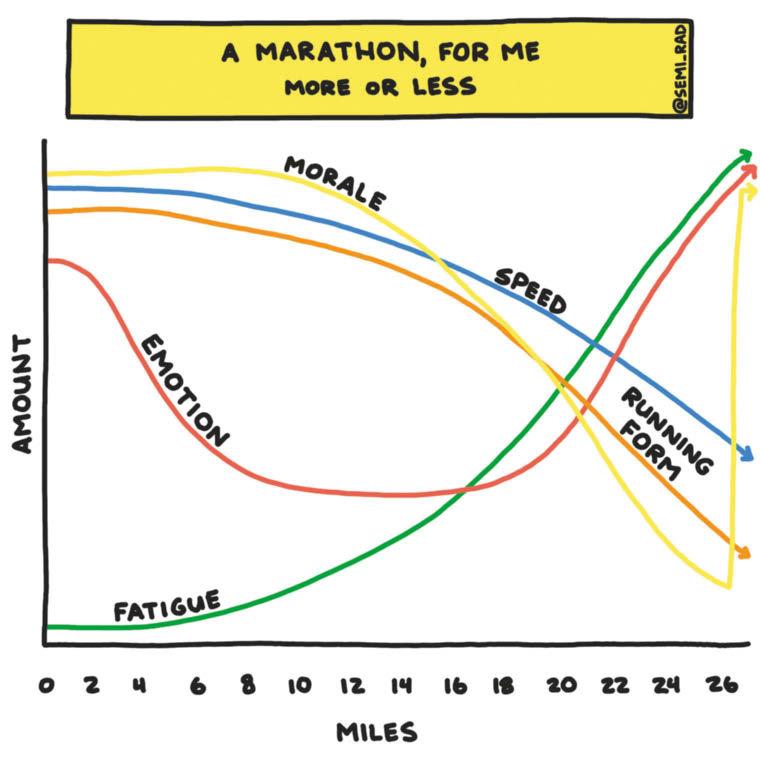

THE MOST CAPABLE RARELY GO IT ALONE.
THE MOST CAPABLE RARELY GO IT ALONE.
THE MOST CAPABLE RARELY GO IT ALONE.








